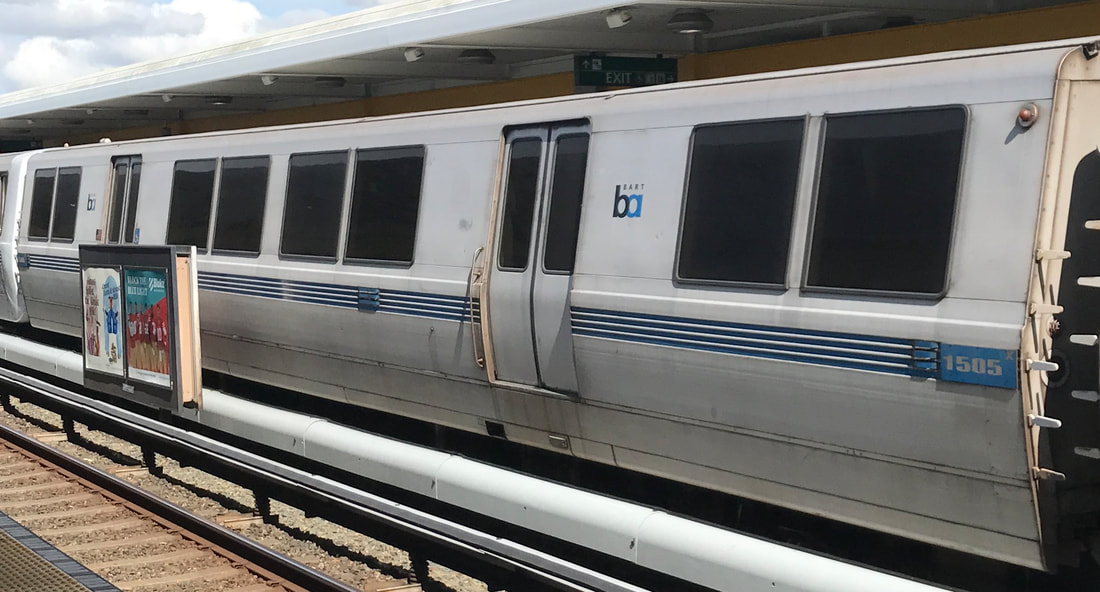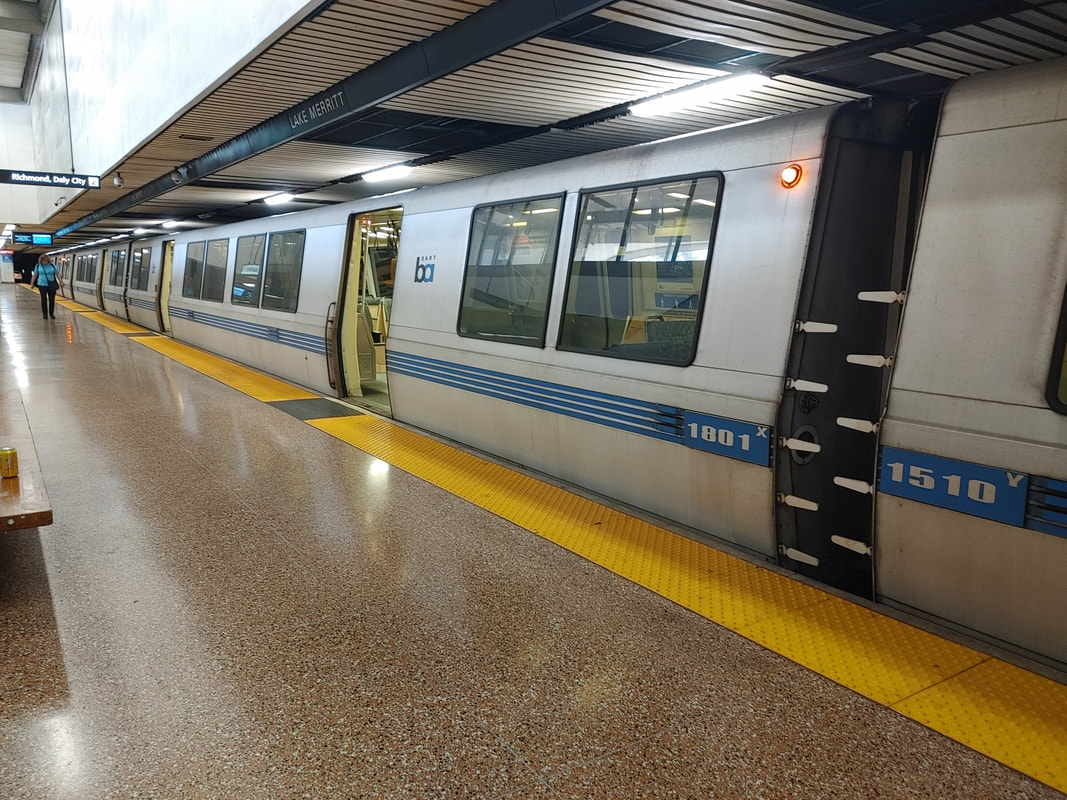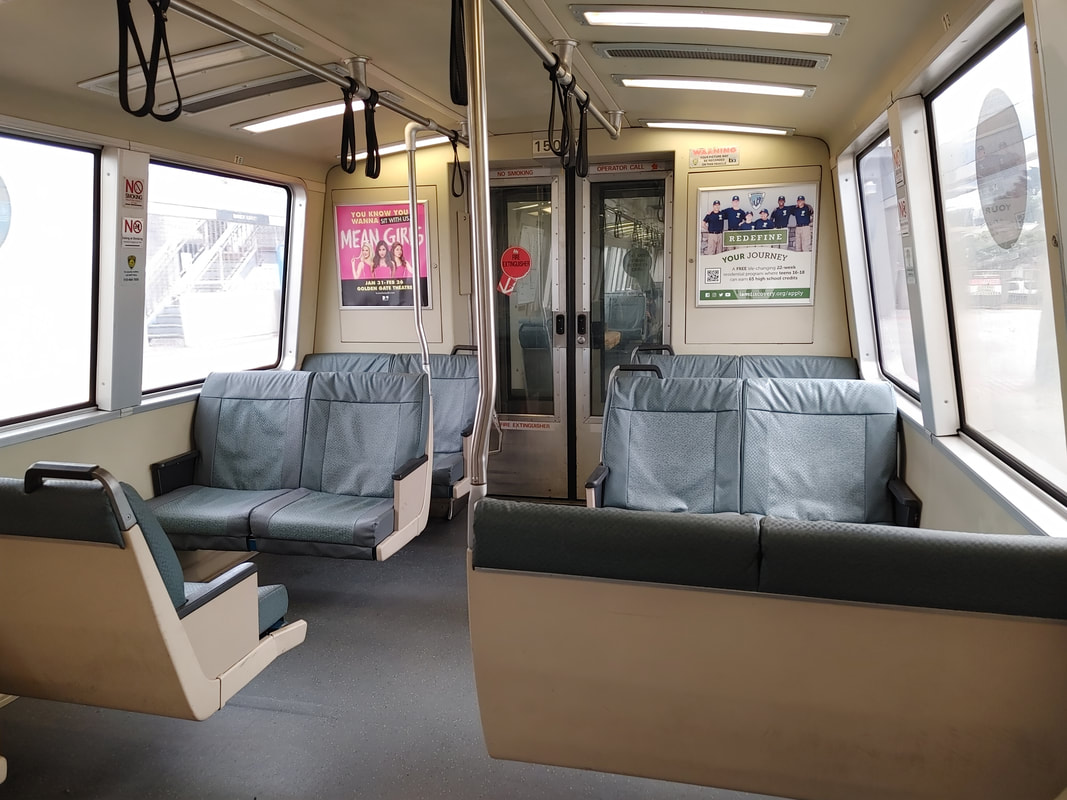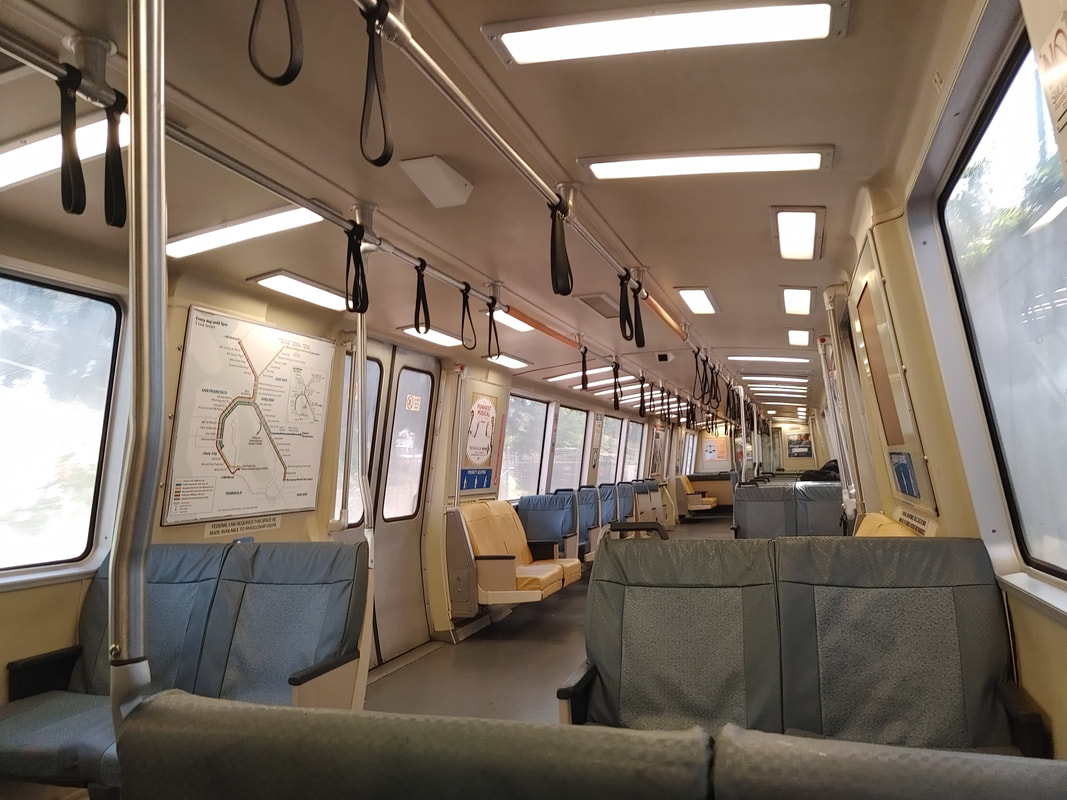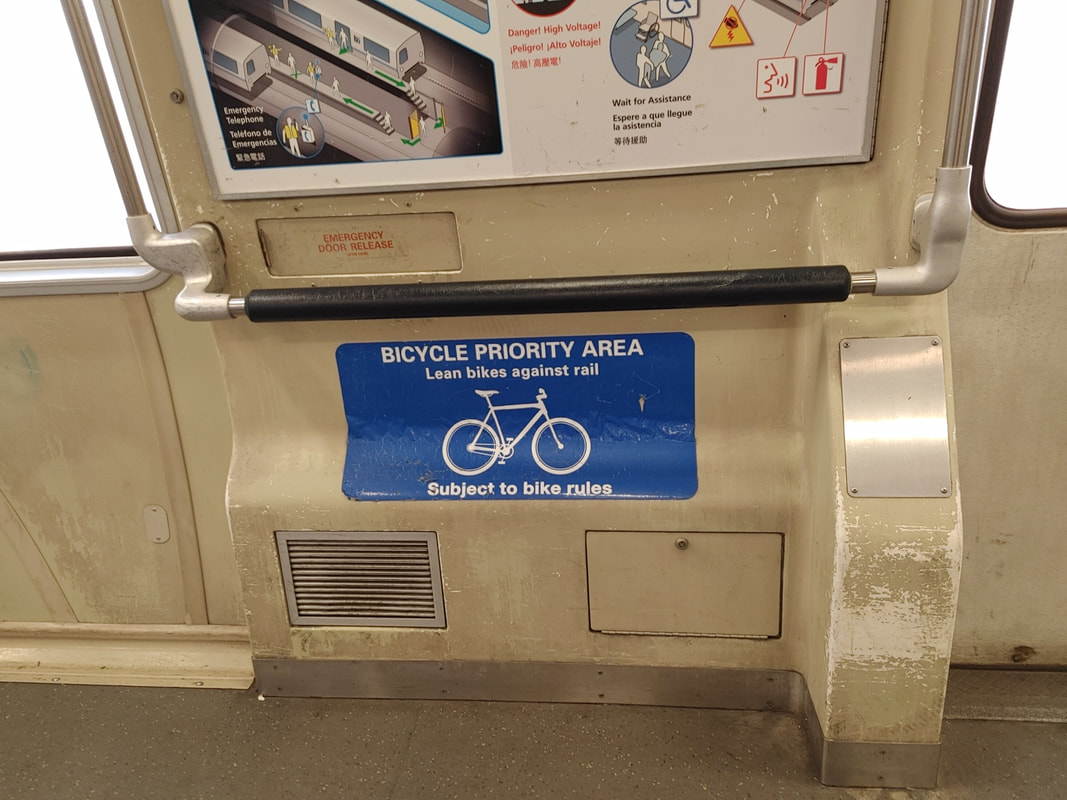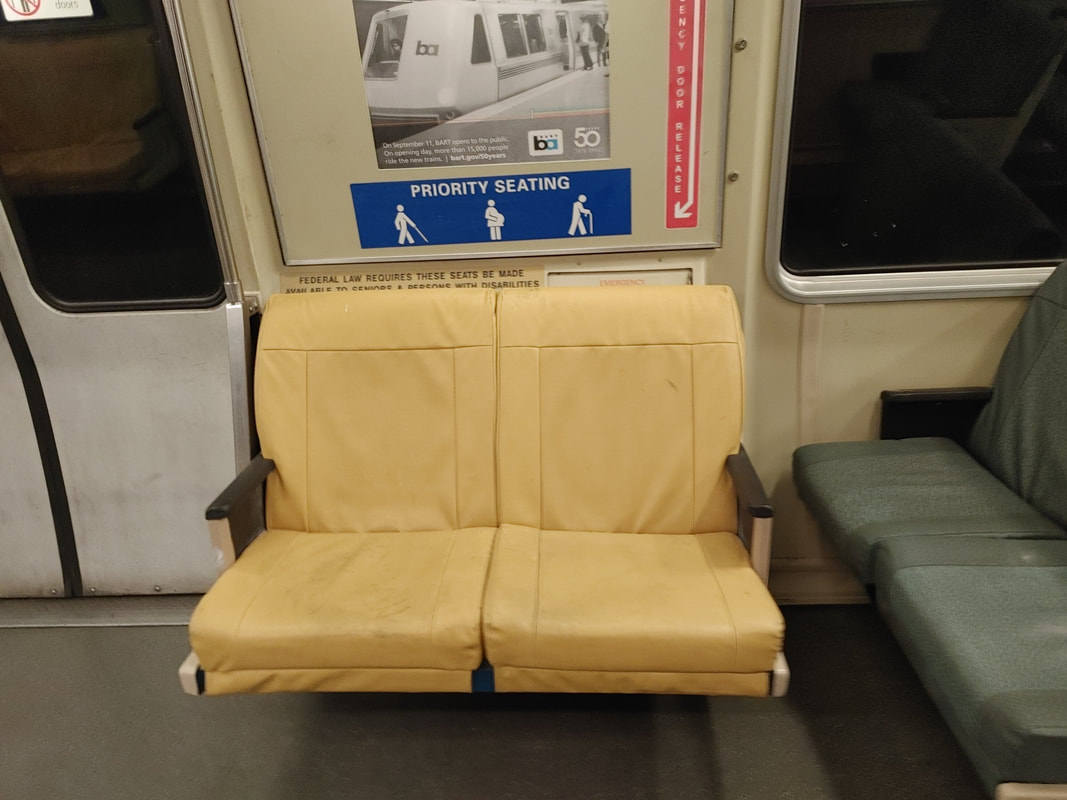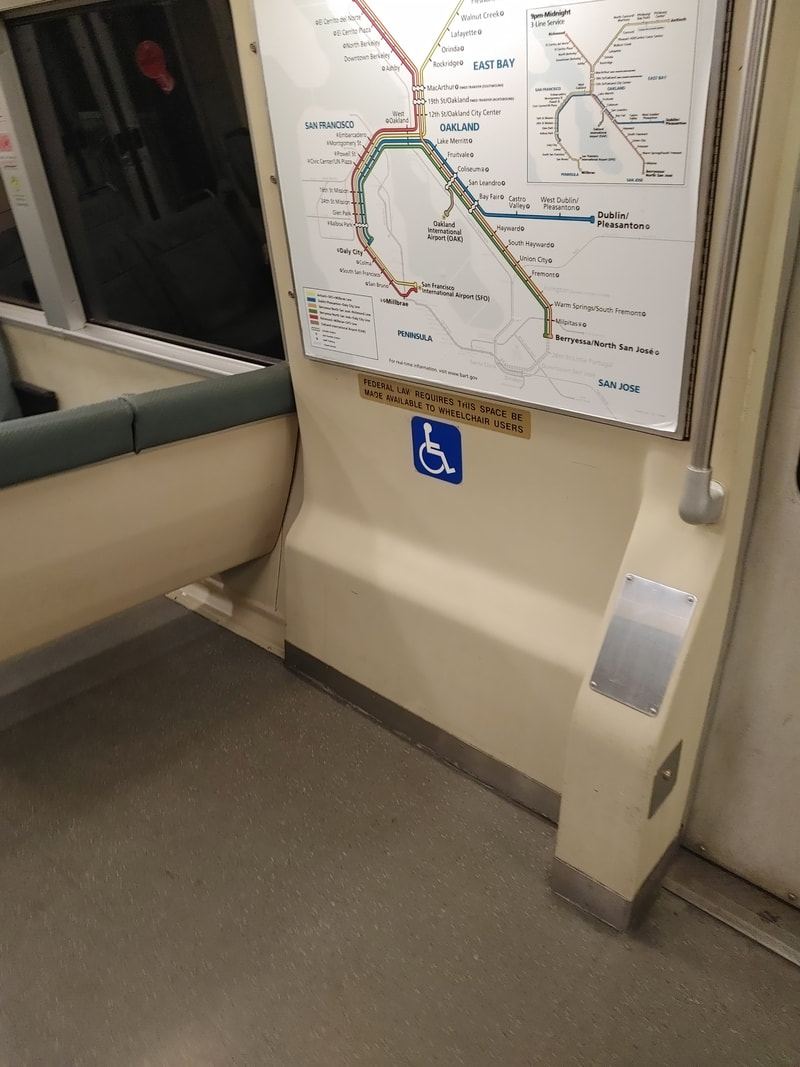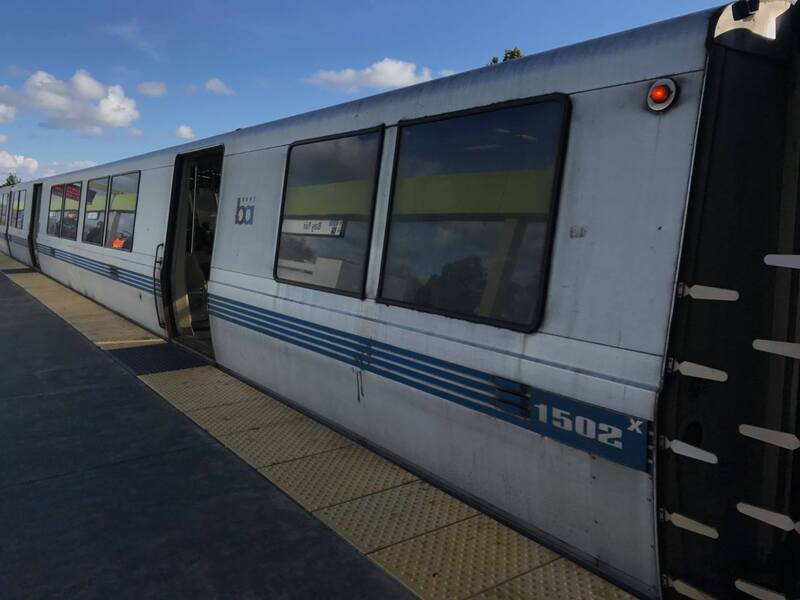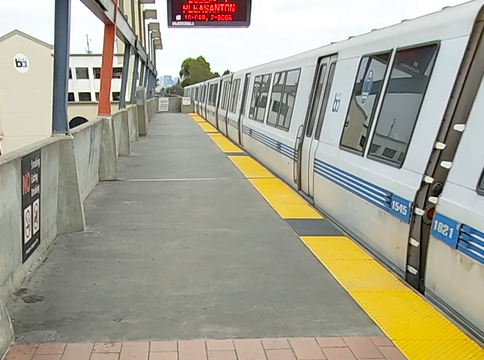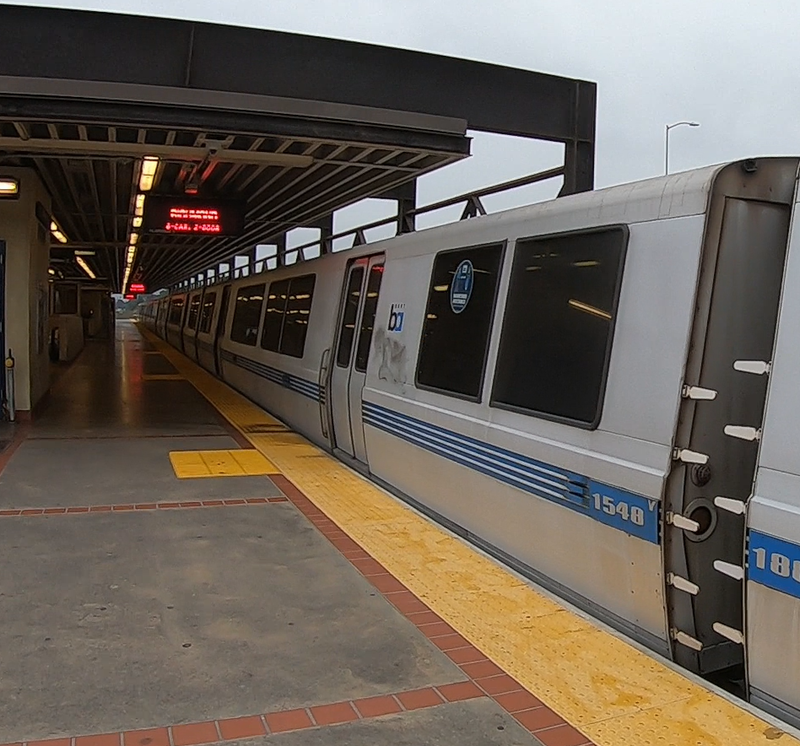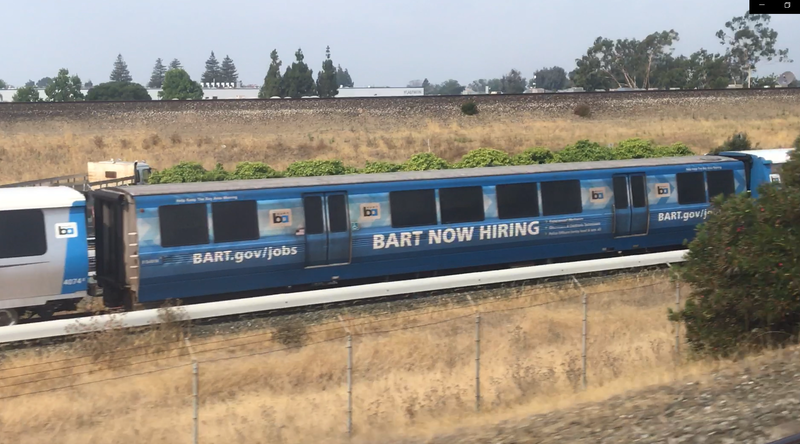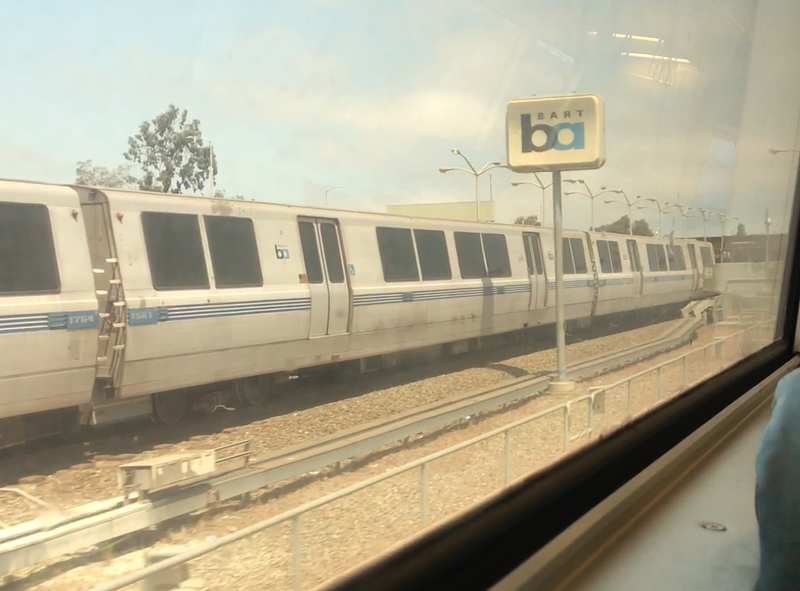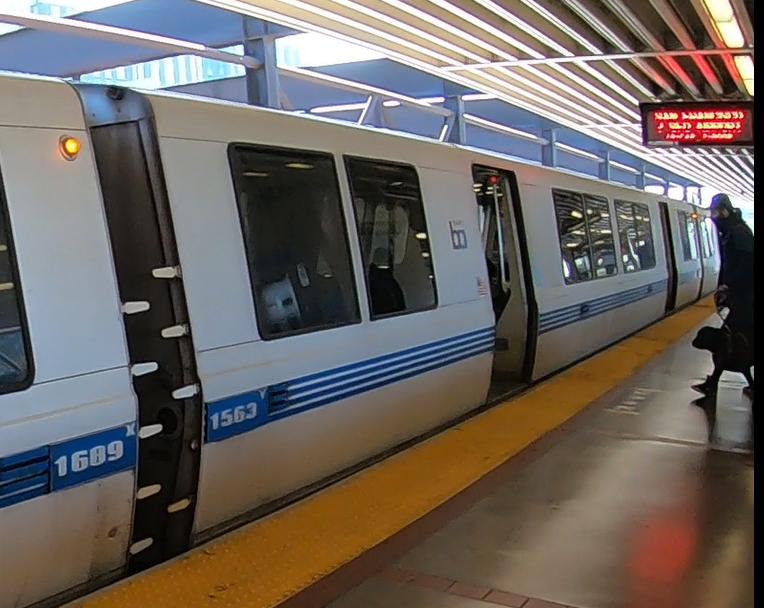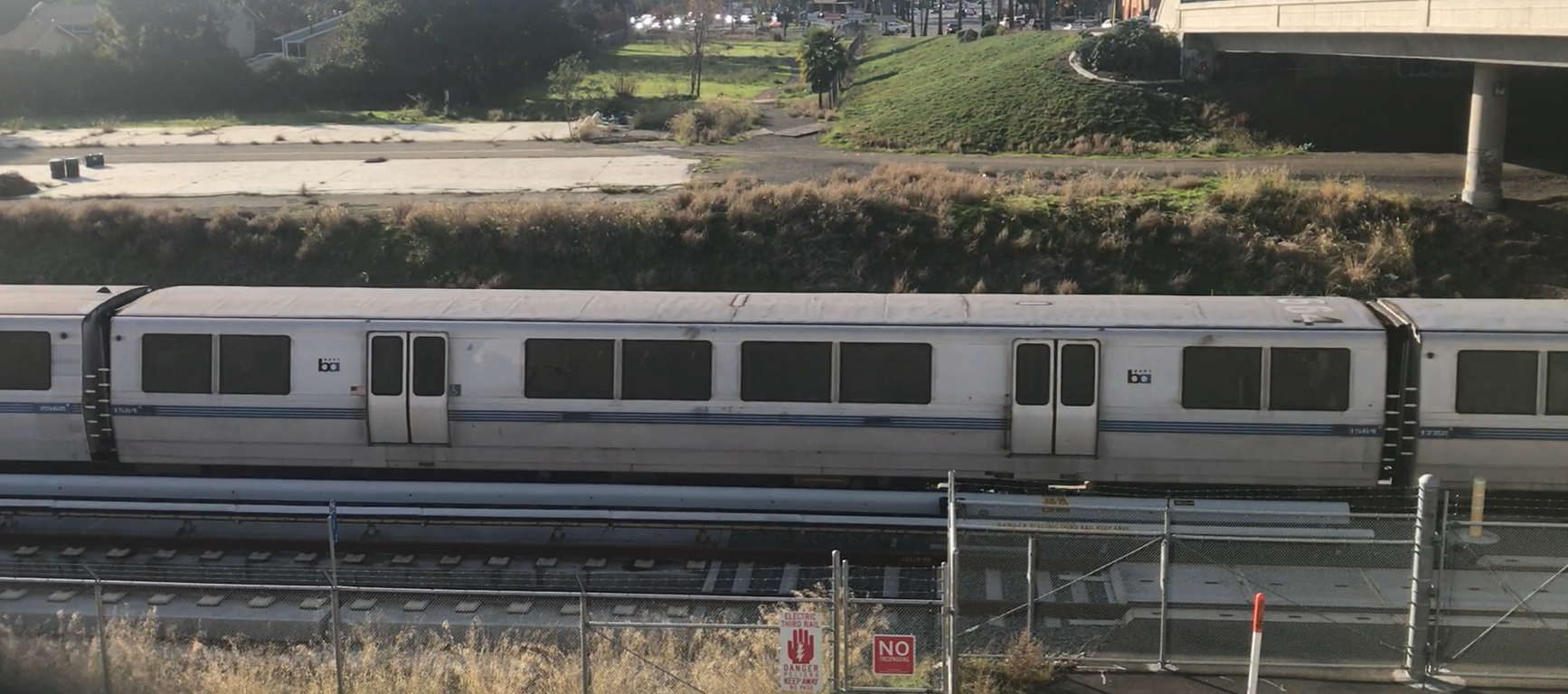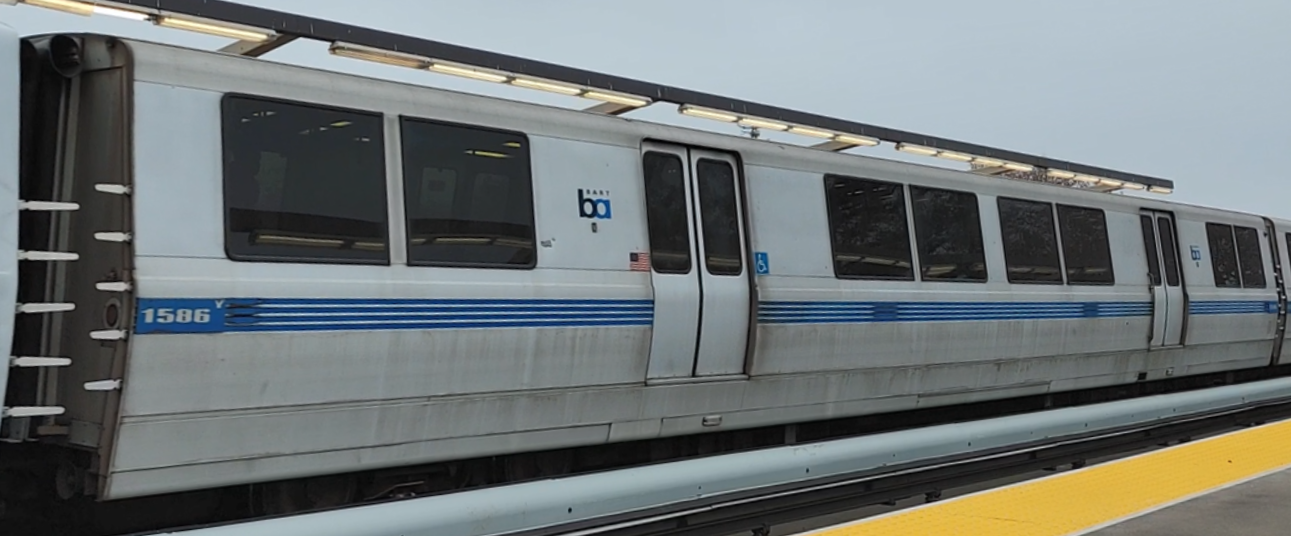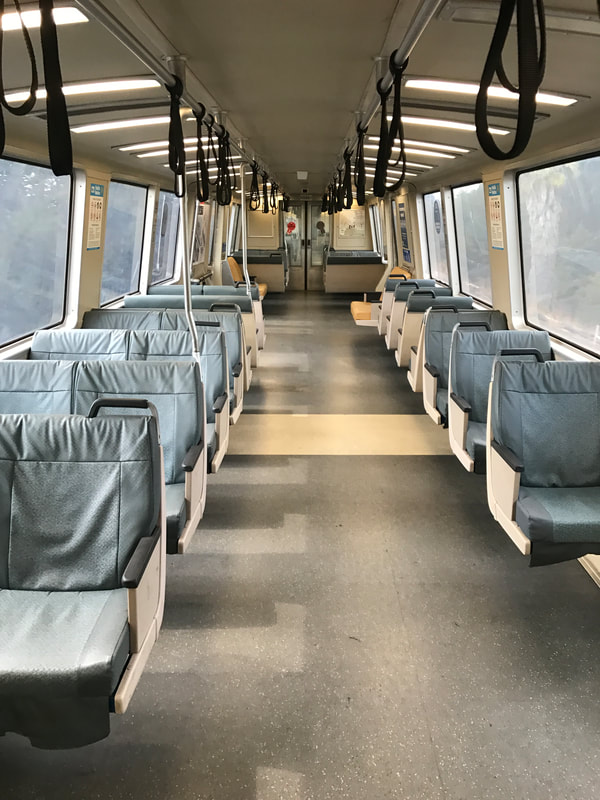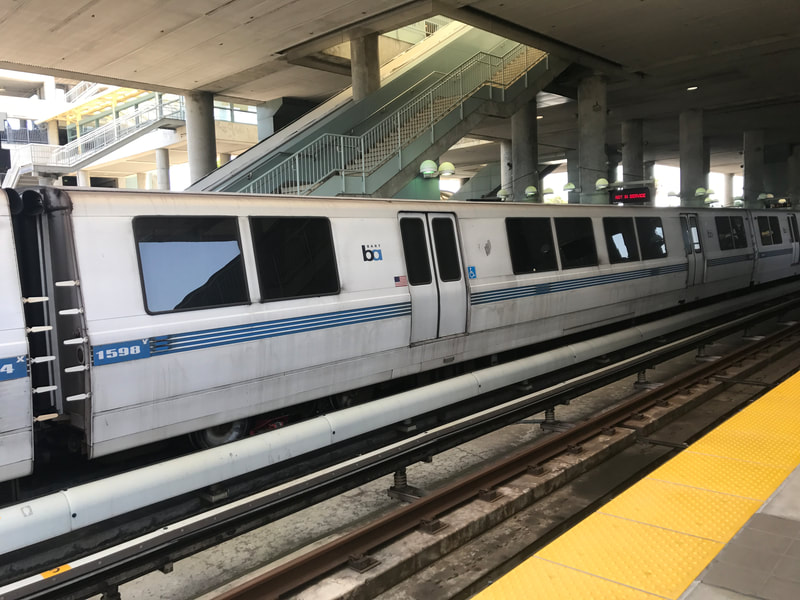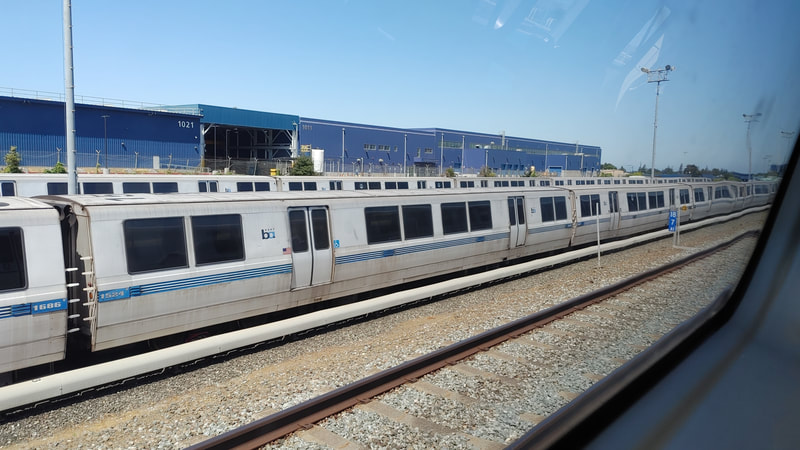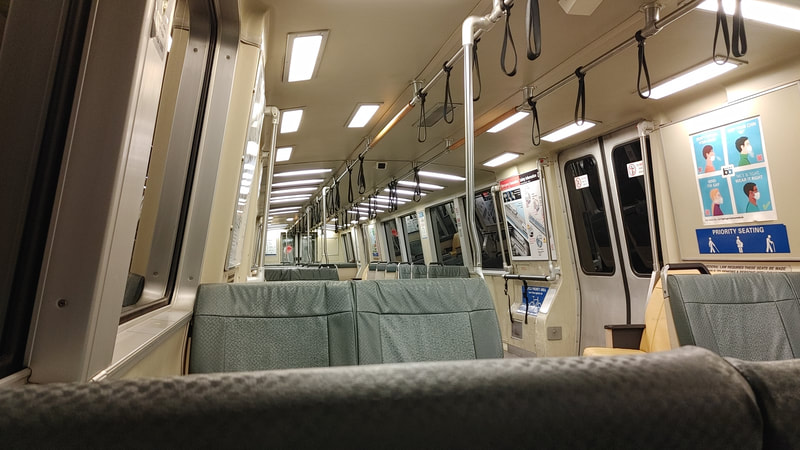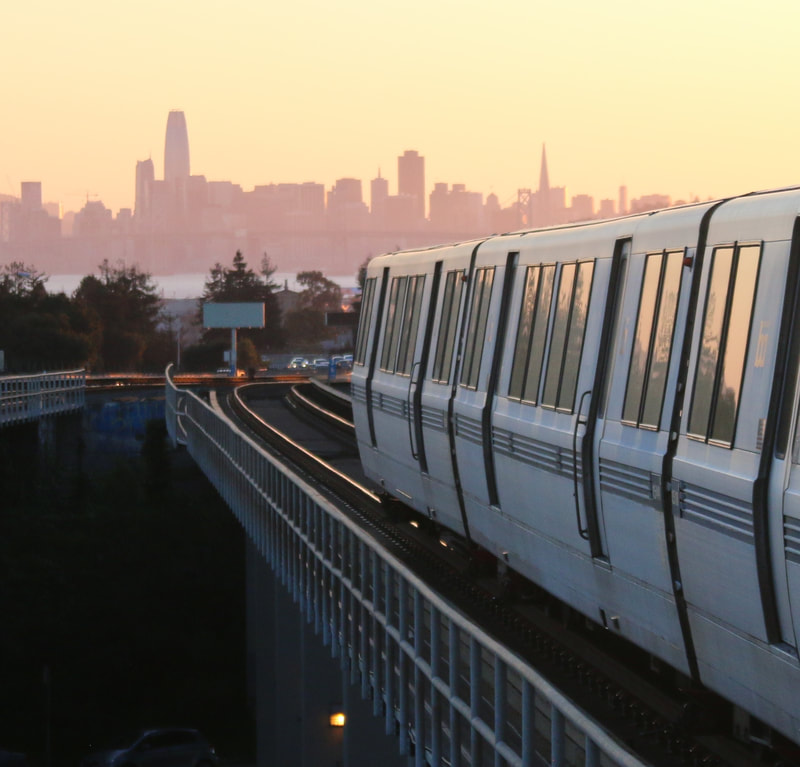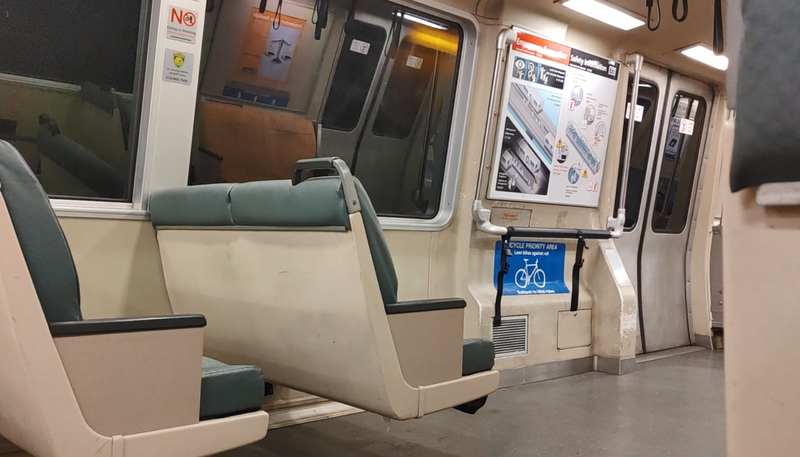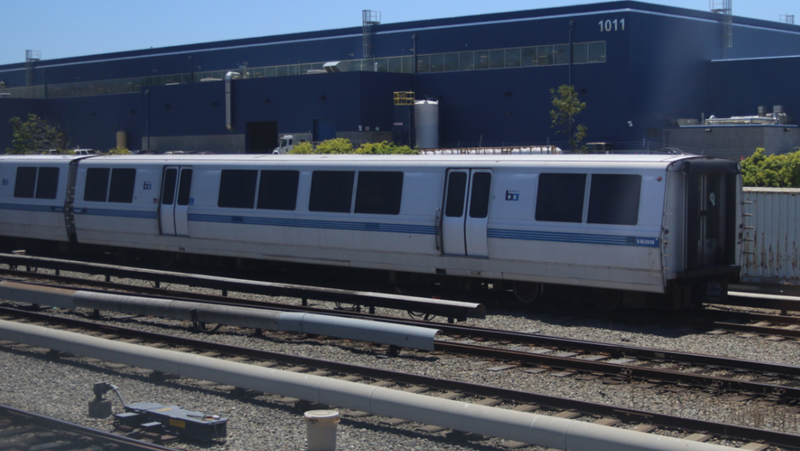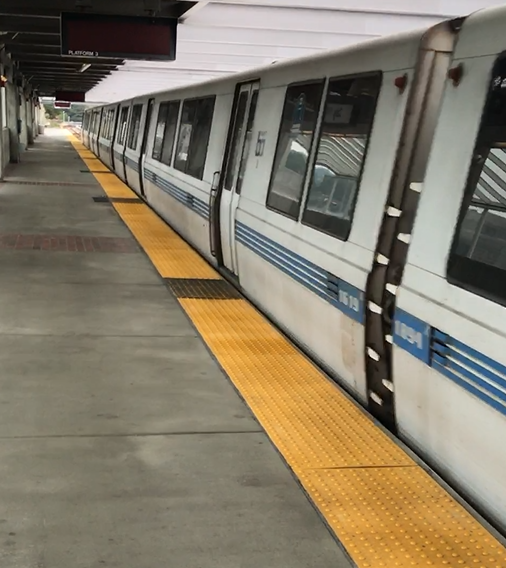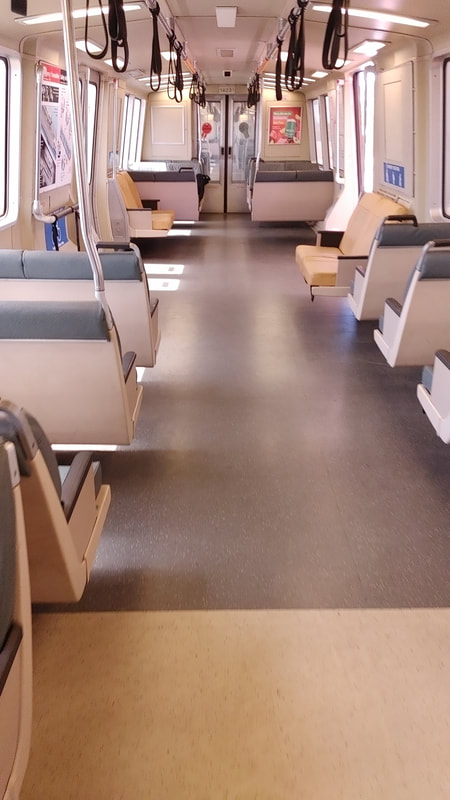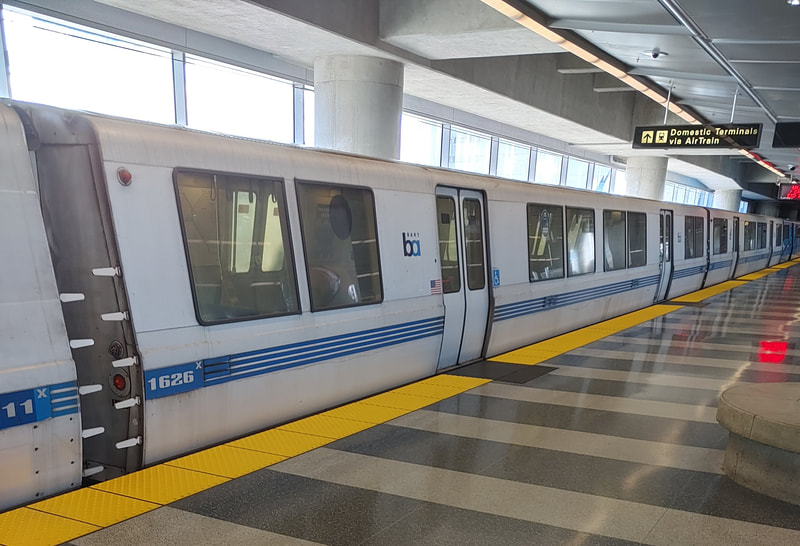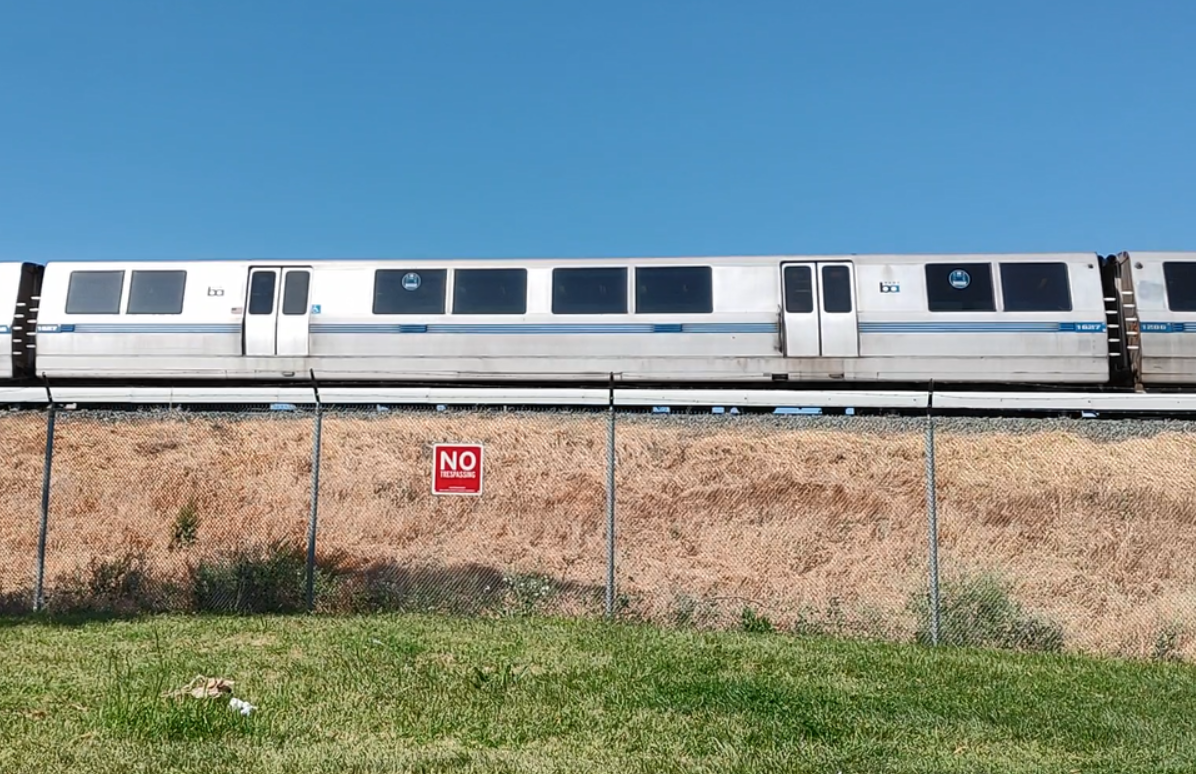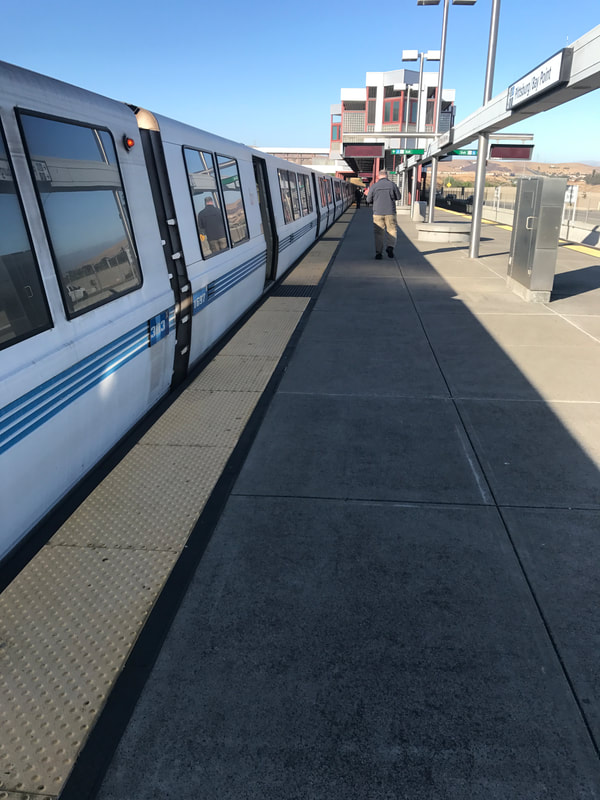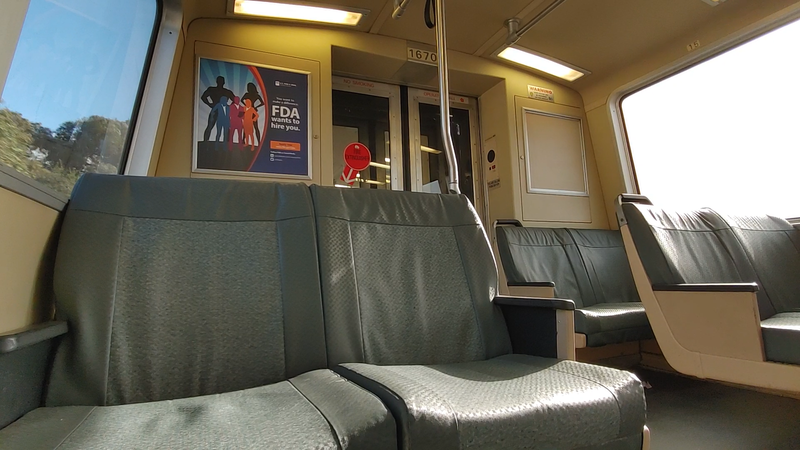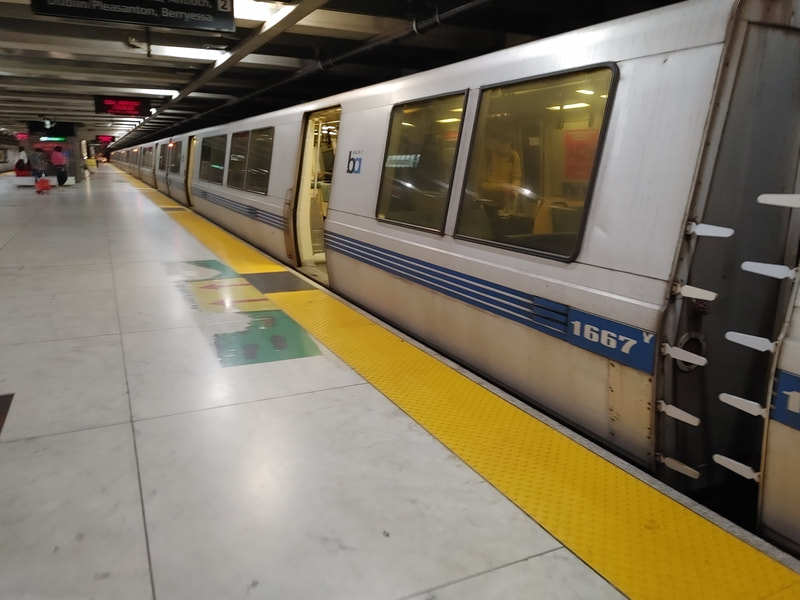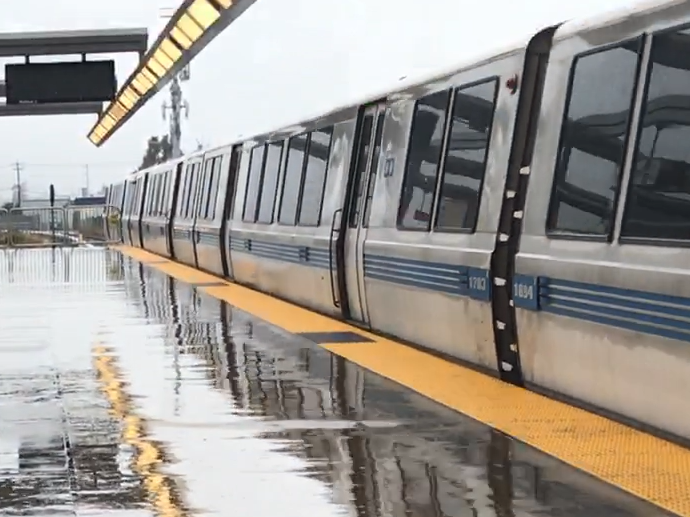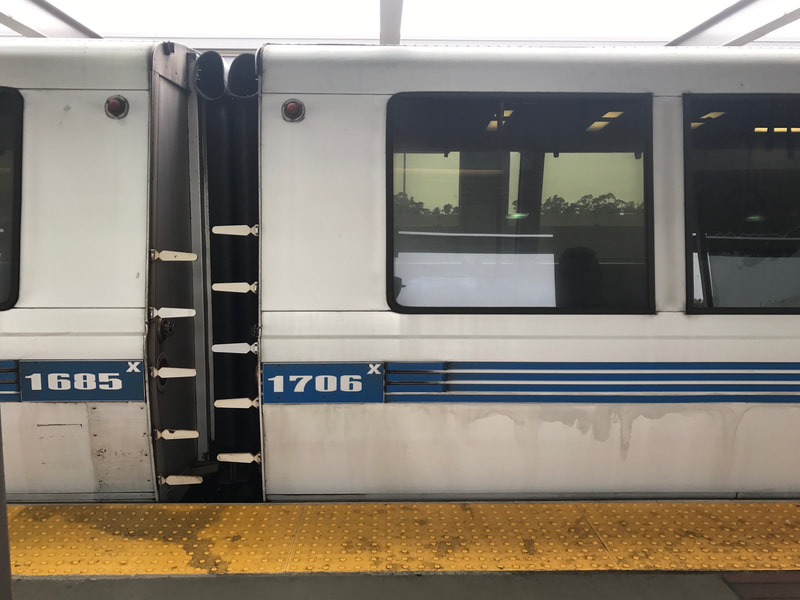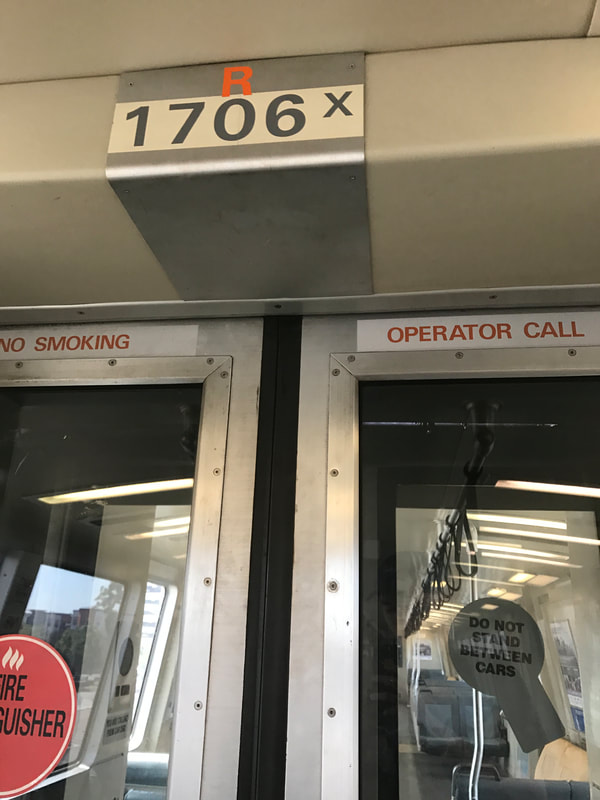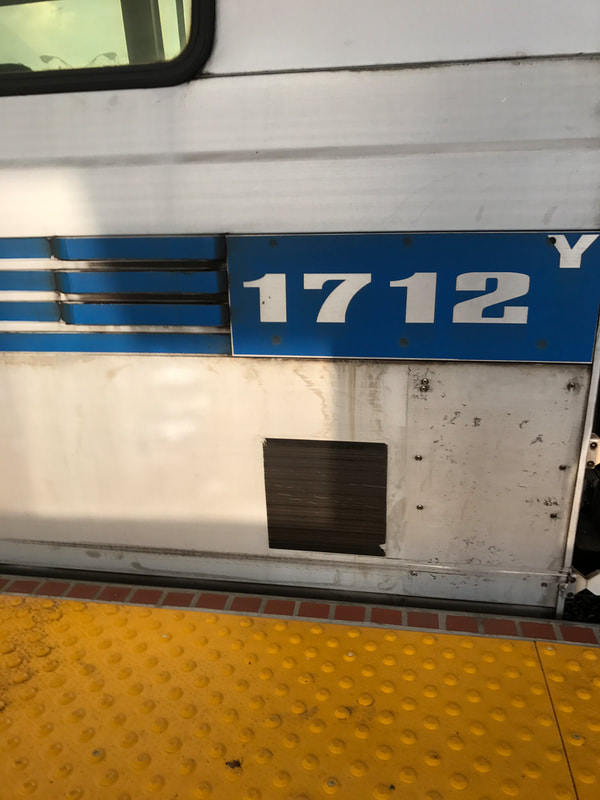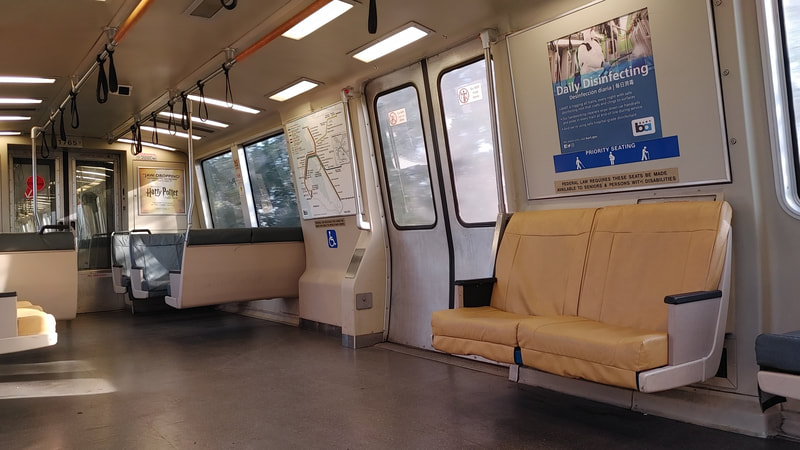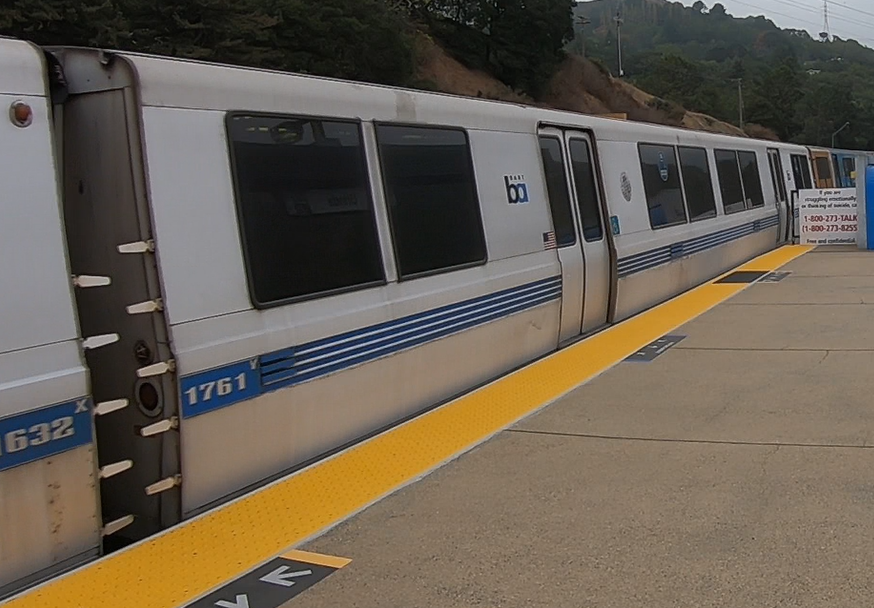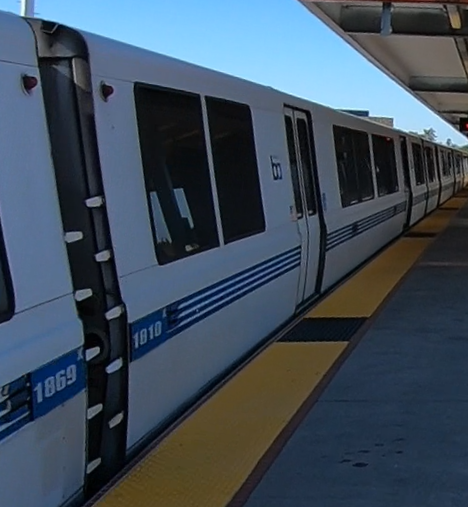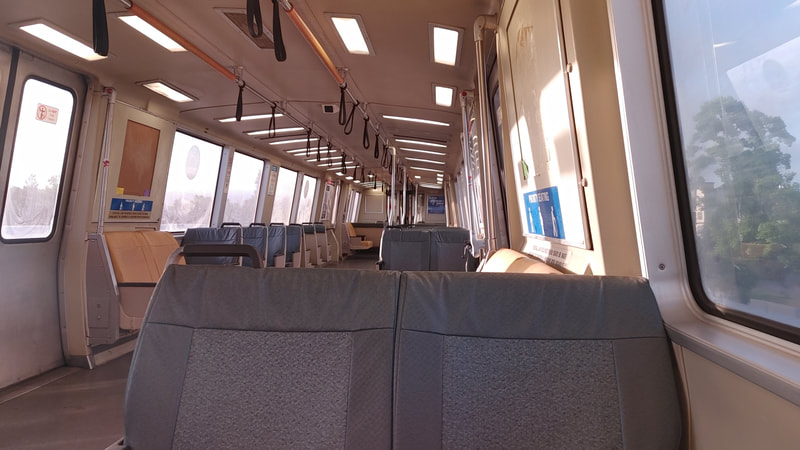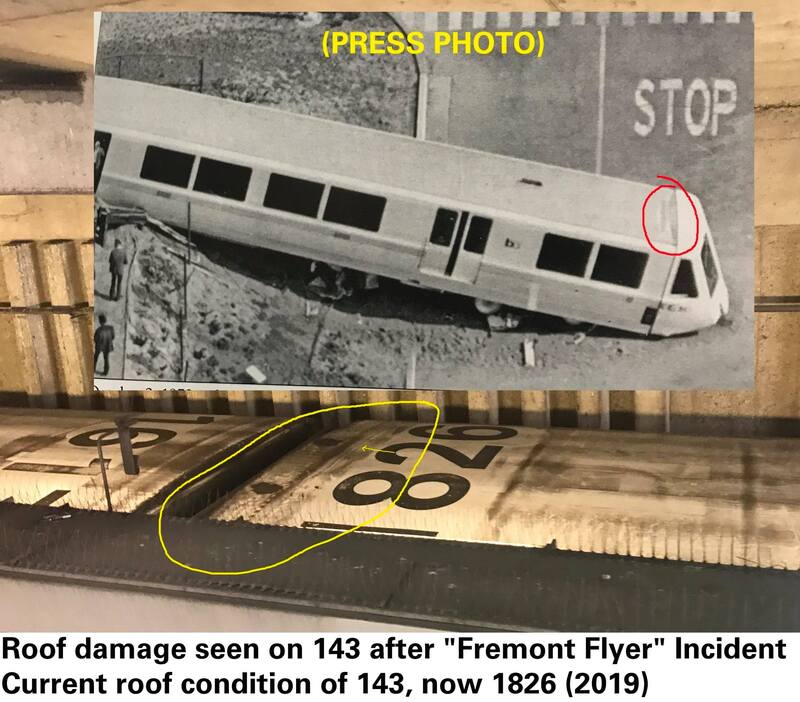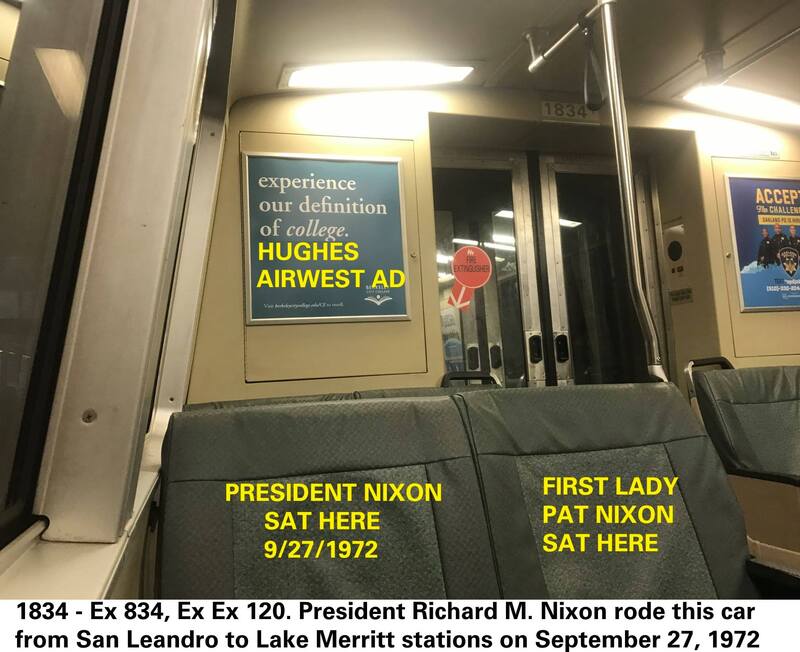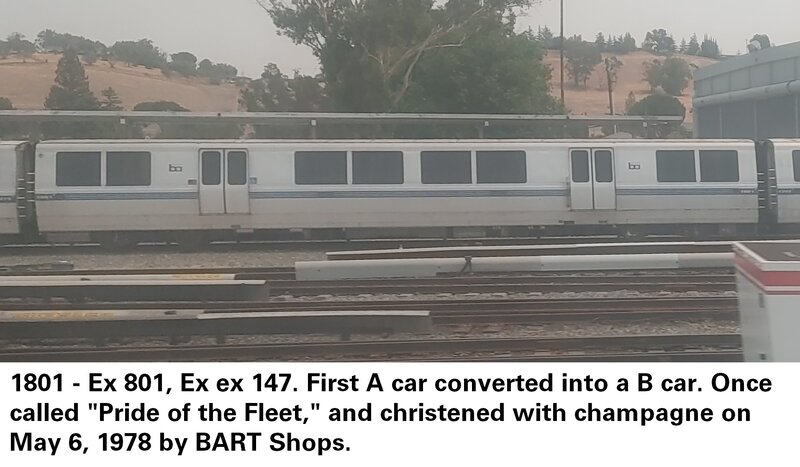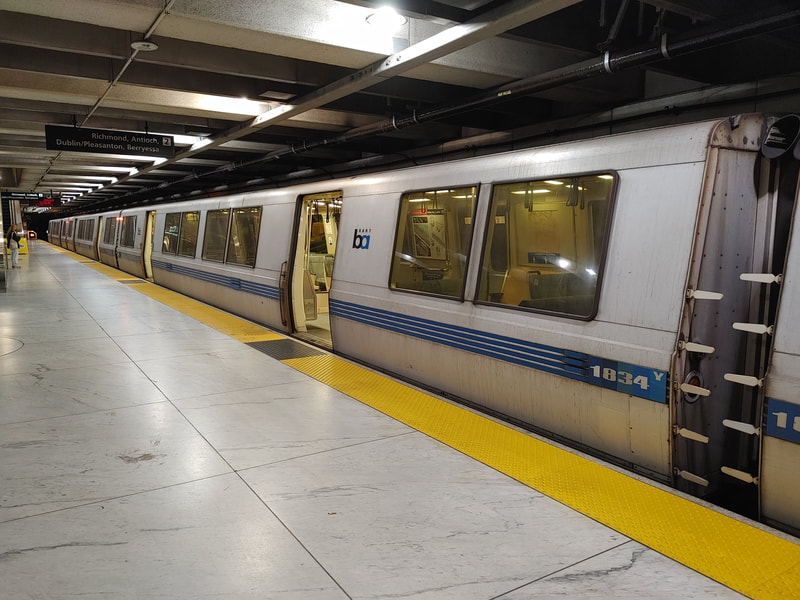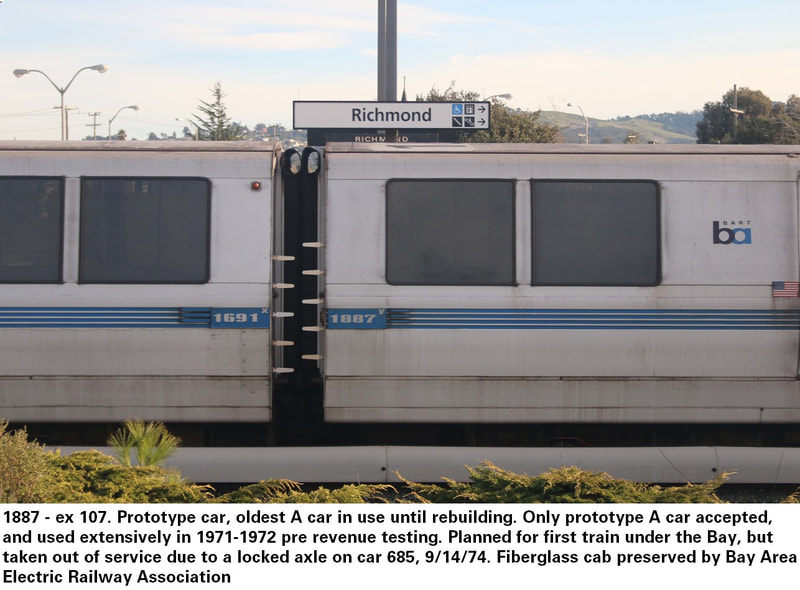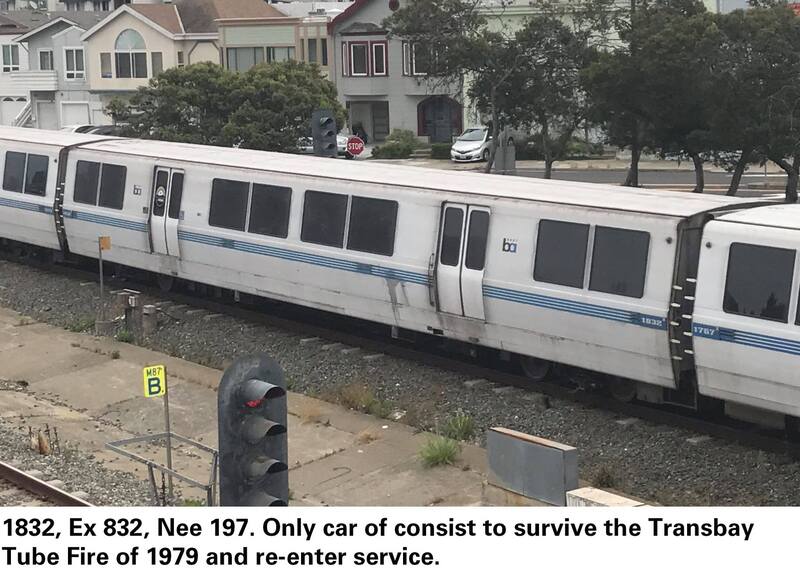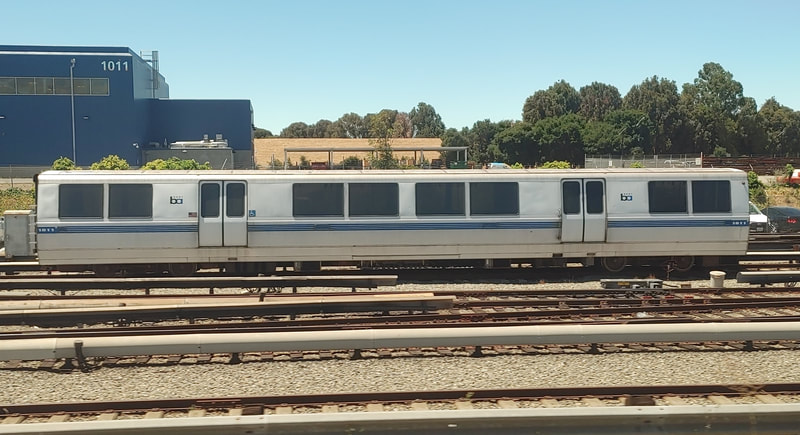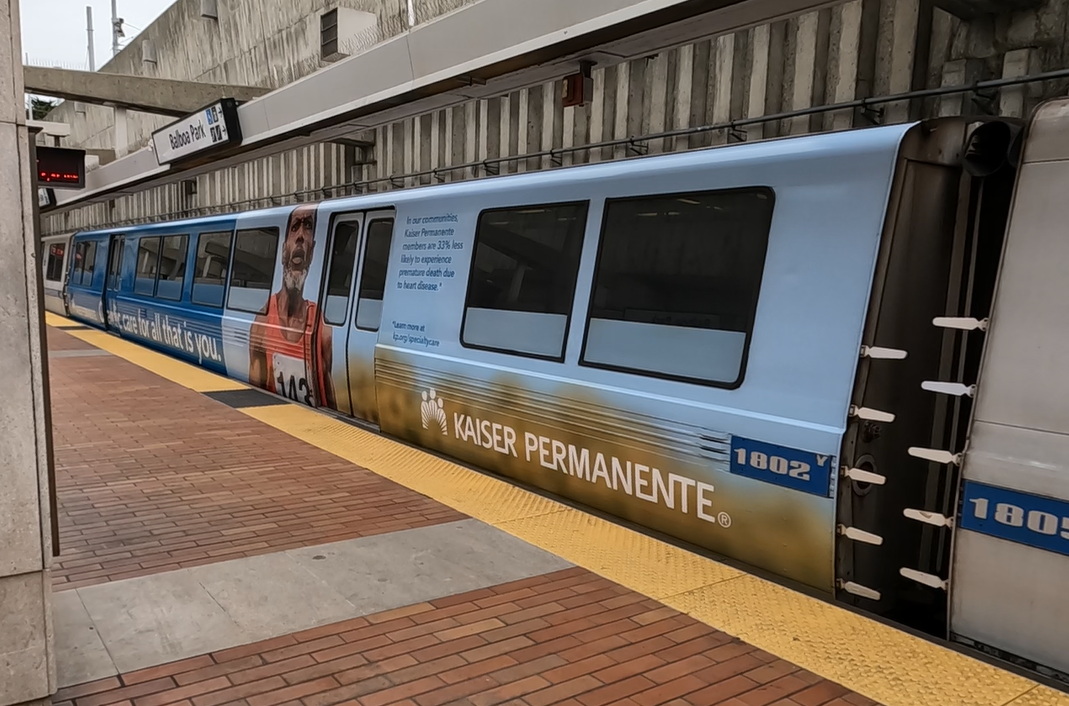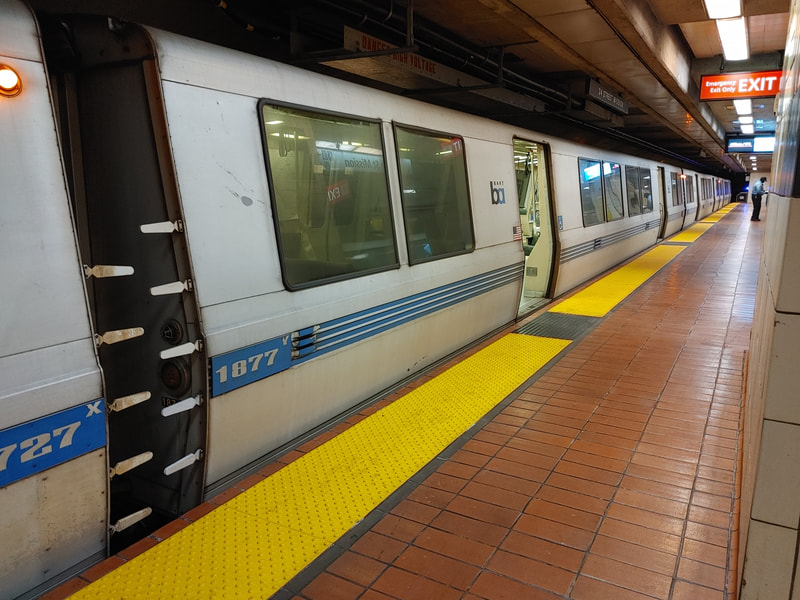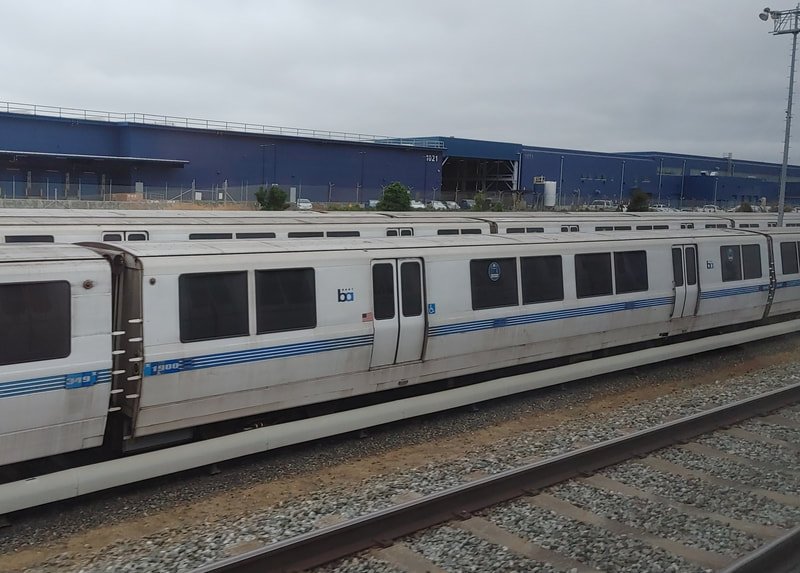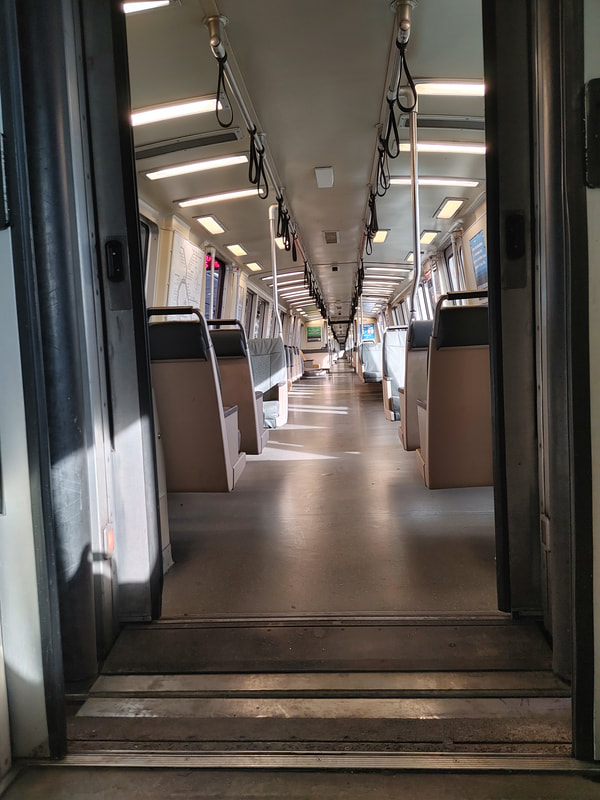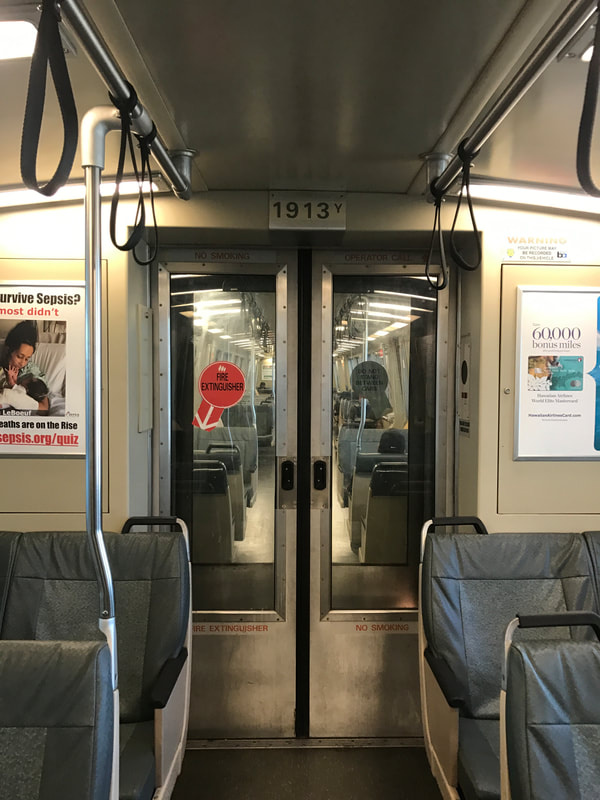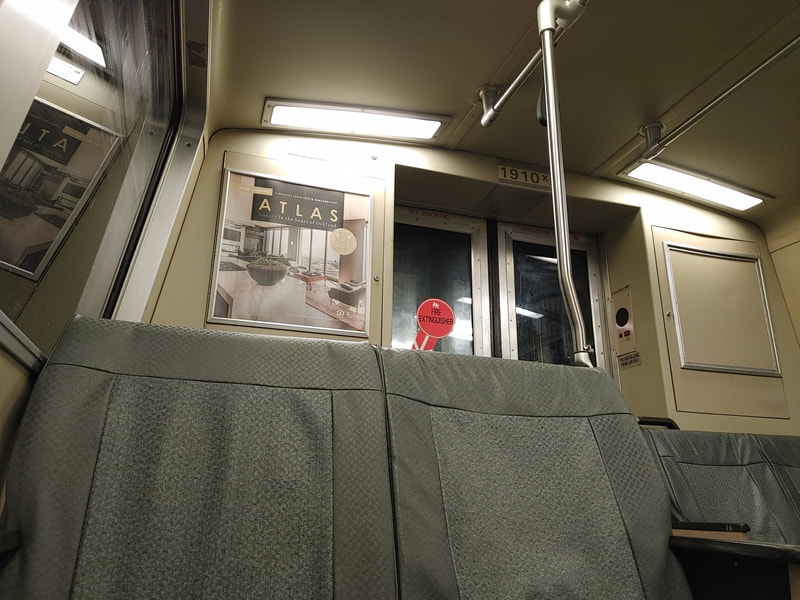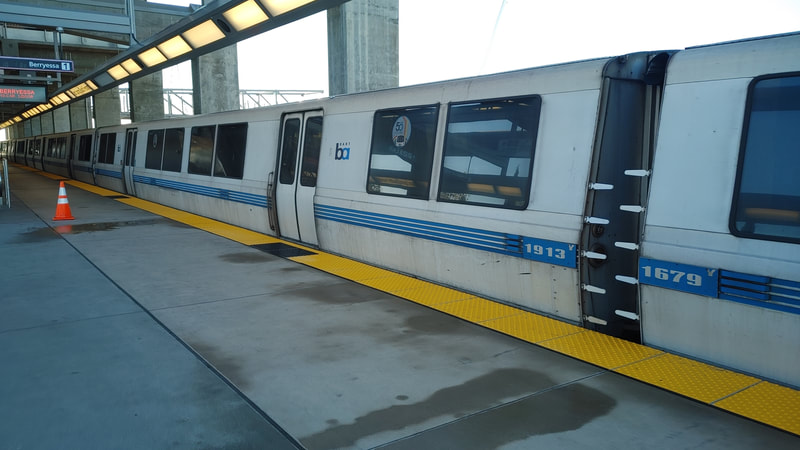B2 Car Background
B2 cars are used in the middle of trains. These cars do not have automatic controls, and rely on a lead and trailing units for their operation in revenue service. They can run under manual control as single units in the yard.
The 1998-2002 rebuilding/conversion process resulted in a 380 car fleet of new B cars (named B2 cars), numbered between 1501 and 1913.
The 1998-2002 rebuilding/conversion process resulted in a 380 car fleet of new B cars (named B2 cars), numbered between 1501 and 1913.
|
B2 Cars numbered 1501-1774 were all formerly B cars 501-774. Some B cars were written off, so there are gaps in the numbering. With rebuilding, the cars gained a new fleet number 1000 more than the previous car number. Thus, 1501 is ex 501.
B2 Cars 1801-1913 were all formerly A cars in one point in time:
|
|
With the completion of the rebuilding program, it has become common parlance to refer to A2 cars as A cars, and B2 cars as B cars. In all but historical context, the terms A and A2 / B and B2 are interchangeable.
Due to their very versatile nature, they ran in every legacy train. As of May 2024, there are 2 B2 cars left, of a fleet once numbering 380. One will go to the Western Railway Museum (#1834) and another (#1759) has found a new use. All other B2 cars were decommissioned and scrapped from January 2020 to May 2024. A few B2 cars had ad wraps. See the Ad Wraps page to view more about these colorful BART cars. |
|
General Details
Original Builder: Rohr Industries, Inc.
Original Build Location: Chula Vista Rohr Plant, Building 61
Original Years of Construction: 1970-1971 (1501-1503, 1887), 1971-1975 (1504-1774, 1801-1913 sans 1887)
Rebuilder: Adtranz/Bombardier
Rebuild Location: Pittsburg, CA
Rebuild Years: 1997-2002
Rebuild cost: Aprox $1.0 million/car
Quantity: 380 (before end of life scrapping)
Length: 70 feet
Weight (Empty): 60,000 - 61,500 lb
Seats: 53
Propulsion: Adtranz AC IGBT-VVVF drive with 4 X 140 HP ADtranz 1507C motors
Brakes: Knorr dynamic/regenerative to 3 mph, Hydraulic friction braking below 3 mph.
Auxiliary Power Supply Equipment (APSE): Bombardier
HVAC: Wabtech, 15 ton
Truck: LFM-Rockwell cast steel, model HPD-3
Electronic Horn: Federal Signal
Coupler: Wabco N3
Number saved: 2 cars
Original Build Location: Chula Vista Rohr Plant, Building 61
Original Years of Construction: 1970-1971 (1501-1503, 1887), 1971-1975 (1504-1774, 1801-1913 sans 1887)
Rebuilder: Adtranz/Bombardier
Rebuild Location: Pittsburg, CA
Rebuild Years: 1997-2002
Rebuild cost: Aprox $1.0 million/car
Quantity: 380 (before end of life scrapping)
Length: 70 feet
Weight (Empty): 60,000 - 61,500 lb
Seats: 53
Propulsion: Adtranz AC IGBT-VVVF drive with 4 X 140 HP ADtranz 1507C motors
Brakes: Knorr dynamic/regenerative to 3 mph, Hydraulic friction braking below 3 mph.
Auxiliary Power Supply Equipment (APSE): Bombardier
HVAC: Wabtech, 15 ton
Truck: LFM-Rockwell cast steel, model HPD-3
Electronic Horn: Federal Signal
Coupler: Wabco N3
Number saved: 2 cars
Car No: Year Built
1501-1503: 1970 (Originally prototype cars)
1504-1549: 1972
1550-1623: 1973
1624-1723: 1974
1724-1774: 1975
1801-1913: 1971-1975 (originally built as A cars)
1501-1503: 1970 (Originally prototype cars)
1504-1549: 1972
1550-1623: 1973
1624-1723: 1974
1724-1774: 1975
1801-1913: 1971-1975 (originally built as A cars)
Exterior
|
The B2 cars feature a brushed (now, more of a chalky) aluminum carbody with four blue trim stripes. Each side has two pairs of side doors allowing for entry and exit.
Each car is equipped with 16 tinted windows (two sizes) and two trouble lights (which indicate conditions such as a door open or brakes stuck on). Each B2 car has 20 intercar barriers (5 per corner), which prevent passengers from falling in between cars. |
Interior
|
Almost every B2 car is equipped with 53 seats. Each seat is generously cushioned, and measure about 21 inches in width with 34 inch pitch (comparable to economy plus in the airline world, and still a bit wider than most).
There are 7 "single" seats in the middle of each B2 car, on the right side (facing forward, the Y direction). These are often the most popular seats, and usually prioritized by commuters traveling alone. On A2 and B2 cars, there are four "pods" (sets of seats facing each other) allowing for multiple riders to converse (or something - it's useful for families but not individual commuters). The arm rests are of the "beige-millstone aluminum/melamine" theme type, a contrast to their original lives as A/B cars and the C1 cars (which had the "wood" theme). There are dozens of grab straps and grab bars located along the ceiling and at certain seats (in lieu of an seat-mounted grab bar). The straps were a relatively recent addition (from the past 10 years), and come in both standard and lowered sizes. Each car is equipped with two maps, two emergency evacuation instructions, and eight ad holders. Both the X and Y ends of each car are equipped with intercar closure doors and tubes, allowing for safe passage between moving cars. |
|
Each B2 car features two assigned spaces for bikes, two assigned spaces for passengers with wheelchairs/mobility aids, and four sideways seats prioritized for passengers with disabilities (seat cushions seated yellow).
Passengers without disabilities are allowed to sit in these priority seats. Signage says these yellow seats are "to be made available" to seniors and persons with diabilities (in line with 49 CFR 37.167, which requires the notice), but there is no legal requirement for the (non-senior) passenger (without disabilities) to vacate the seat. That being said, it is good practice and good for society to offer these seats to people who need them, when they request for them. Each B2 car is equipped with four cameras, for safety. Both the X and Y ends of each car are equipped with an intercom, linking the patron to the train operator. This can be used to contact the operator in an emergency. Additionally, each car is equipped with two fire extinguishers, and an emergency plank. |
Car by Car
All details subject to change due to legacy fleet decommissioning process.
Up to date as of April 2024
Up to date as of April 2024
1501-1599
The 1500s (and 1600) were built as part of the first order for BART revenue vehicles, ordered in 1969.
1501 - Oldest car on BART. First B Car, third BART legacy car built, Prototype Car. Frame built 9/1970, delivery 12/1/1970. Car had a swing in it (public art idea) 11/19/09. In service on 4/20/2024 - Final run of the Legacy Fleet. Scrapped after final run.
1502 - Scrapped. Prototype Car, fifth BART car built. Derailed during testing at Hayward yard, 3/5/71.
1503 - Scrapped. Prototype Car, sixth BART car built.
1504 - First Production Car, 11th car built, delivered Feb 8, 72. In service on Day One, 9/11/1972. Board of Directors agreed to preserve this car back in the 1970s. Scrapped, but parts preserved by Western Railway Museum.
1505 - Delivered Feb 8, 72, accepted by BART 4/21/1972. In service on Day One, 9/11/1972. Part of the Nixon Trainset. Scrapped.
1506 - Scrapped.
1507 - Scrapped
1508 - Scrapped.
1509 - BART Jobs Ad wrap
1510 - Former Test Seating Layout car. Scrapped.
No 1511 - Car 511 destroyed by electrical fire in 1979
1512 - In service on 4/20/2024 - Final run of the Legacy Fleet. Scrapped.
1513 - Scrapped 2/7/2020
1514 - Scrapped 3/24/2021
1515 - In service on 4/20/2024 - Final run of the Legacy Fleet. Scrapped.
1516 - Scrapped.
1517 - Scrapped
1518 - Scrapped
1519 - Scrapped
1520 - Scrapped.
1521 - Former Test Seating Layout car. Scrapped.
1522 - Scrapped
1523 - Scrapped.
1524 - Bike strap test car. Scrapped
1525 - Scrapped
1526 - Scrapped
1527 - Scrapped
1528 - Scrapped.
1529 - Scrapped
1530 - Scrapped
1531 - Scrapped.
1532 - Scrapped
1533 - Scrapped
1534 - Scrapped
1535 - Scrapped.
1536 - Scrapped.
1537 - Scrapped.
1538 - Scrapped
1539 - Scrapped
1540 - Scrapped
1541 - Scrapped.
1542 - Scrapped
1543 - Scrapped.
1544 - Scrapped
1545 - Scrapped.
1546 - Scrapped
No 1547 - Car 547 written off in Transbay Tube Fire, used for fire testing post incident.
1548 - In service on 4/20/2024 - Final run of the Legacy Fleet. Scrapped.
1549 - Scrapped.
1550 - Repaired Y end, left side (collision). Scrapped.
1551 - White center floor marker. Scrapped
1552 - Scrapped
1553 - Scrapped
1554 - Scrapped
1555 - Scrapped
1556 - Scrapped.
1557 - Stored 2019, scrapped
1558 - Scrapped
1559 - Scrapped
1560 - Scrapped.
1561 - Scrapped.
1562 - Used in filming of Fruitvale Station. Scrapped.
1563 - Scrapped.
1564 - Damaged Y end. Scrapped
1565 - Former Test Seating Layout car. Scrapped
1566 - Scrapped.
1567 - Scrapped
1568 - Scrapped
1569 - Scrapped
1570 - Scrapped
1571 - Scrapped
1572 - Scrapped
1573 - Scrapped
1574 - Scrapped
1575 - Scrapped.
1576 - Scrapped
1577 - Zoho One ad wrap 5/22. Scrapped.
1578 - Scrapped
1579 - Scrapped
1580 - In service on 4/20/2024 - Final run of the Legacy Fleet. Scrapped.
No 1581 - Car 581 destroyed in Transbay Tube Fire
1582 - BART PD Now Hiring ad wrap. Scrapped
1583 - Scrapped.
1584 - In service on 4/20/2024 - Final run of the Legacy Fleet. Scrapped.
1585 - Scrapped
1586 - Scrapped
1587 - Zoho One ad wrap 5/22. In service on 4/20/2024 - Final run of the Legacy Fleet. Scrapped. Final B2 car to be scrapped.
1588 - Scrapped
1589 - Scrapped.
1590 - Scrapped.
1591 - Scrapped
1592 - Scrapped
1593 - Last Car in BART operation to have carpet on 6/9/15
1594 - Scrapped.
1595 - Scrapped
1596 - In service on 4/20/2024 - Final run of the Legacy Fleet. Former Test Seating Layout car. Scrapped.
1597 - Scrapped
1598 - Scrapped
1599 - Scrapped
1502 - Scrapped. Prototype Car, fifth BART car built. Derailed during testing at Hayward yard, 3/5/71.
1503 - Scrapped. Prototype Car, sixth BART car built.
1504 - First Production Car, 11th car built, delivered Feb 8, 72. In service on Day One, 9/11/1972. Board of Directors agreed to preserve this car back in the 1970s. Scrapped, but parts preserved by Western Railway Museum.
1505 - Delivered Feb 8, 72, accepted by BART 4/21/1972. In service on Day One, 9/11/1972. Part of the Nixon Trainset. Scrapped.
1506 - Scrapped.
1507 - Scrapped
1508 - Scrapped.
1509 - BART Jobs Ad wrap
1510 - Former Test Seating Layout car. Scrapped.
No 1511 - Car 511 destroyed by electrical fire in 1979
1512 - In service on 4/20/2024 - Final run of the Legacy Fleet. Scrapped.
1513 - Scrapped 2/7/2020
1514 - Scrapped 3/24/2021
1515 - In service on 4/20/2024 - Final run of the Legacy Fleet. Scrapped.
1516 - Scrapped.
1517 - Scrapped
1518 - Scrapped
1519 - Scrapped
1520 - Scrapped.
1521 - Former Test Seating Layout car. Scrapped.
1522 - Scrapped
1523 - Scrapped.
1524 - Bike strap test car. Scrapped
1525 - Scrapped
1526 - Scrapped
1527 - Scrapped
1528 - Scrapped.
1529 - Scrapped
1530 - Scrapped
1531 - Scrapped.
1532 - Scrapped
1533 - Scrapped
1534 - Scrapped
1535 - Scrapped.
1536 - Scrapped.
1537 - Scrapped.
1538 - Scrapped
1539 - Scrapped
1540 - Scrapped
1541 - Scrapped.
1542 - Scrapped
1543 - Scrapped.
1544 - Scrapped
1545 - Scrapped.
1546 - Scrapped
No 1547 - Car 547 written off in Transbay Tube Fire, used for fire testing post incident.
1548 - In service on 4/20/2024 - Final run of the Legacy Fleet. Scrapped.
1549 - Scrapped.
1550 - Repaired Y end, left side (collision). Scrapped.
1551 - White center floor marker. Scrapped
1552 - Scrapped
1553 - Scrapped
1554 - Scrapped
1555 - Scrapped
1556 - Scrapped.
1557 - Stored 2019, scrapped
1558 - Scrapped
1559 - Scrapped
1560 - Scrapped.
1561 - Scrapped.
1562 - Used in filming of Fruitvale Station. Scrapped.
1563 - Scrapped.
1564 - Damaged Y end. Scrapped
1565 - Former Test Seating Layout car. Scrapped
1566 - Scrapped.
1567 - Scrapped
1568 - Scrapped
1569 - Scrapped
1570 - Scrapped
1571 - Scrapped
1572 - Scrapped
1573 - Scrapped
1574 - Scrapped
1575 - Scrapped.
1576 - Scrapped
1577 - Zoho One ad wrap 5/22. Scrapped.
1578 - Scrapped
1579 - Scrapped
1580 - In service on 4/20/2024 - Final run of the Legacy Fleet. Scrapped.
No 1581 - Car 581 destroyed in Transbay Tube Fire
1582 - BART PD Now Hiring ad wrap. Scrapped
1583 - Scrapped.
1584 - In service on 4/20/2024 - Final run of the Legacy Fleet. Scrapped.
1585 - Scrapped
1586 - Scrapped
1587 - Zoho One ad wrap 5/22. In service on 4/20/2024 - Final run of the Legacy Fleet. Scrapped. Final B2 car to be scrapped.
1588 - Scrapped
1589 - Scrapped.
1590 - Scrapped.
1591 - Scrapped
1592 - Scrapped
1593 - Last Car in BART operation to have carpet on 6/9/15
1594 - Scrapped.
1595 - Scrapped
1596 - In service on 4/20/2024 - Final run of the Legacy Fleet. Former Test Seating Layout car. Scrapped.
1597 - Scrapped
1598 - Scrapped
1599 - Scrapped
1600-1699
Car 1600 was the last B car of the original 1969 250 car order. Cars 1601-1700 (100 B cars) were originally built under the second order dated 1972.
1600 - Scrapped.
1601 - Scrapped
1602 - Scrapped
1603 - Scrapped
1604 - Repaired Y end, from derailment. Scrapped
1605 - In service on 4/20/2024 - Final run of the Legacy Fleet. Sidelined, but later rebuilt following derailment. Scrapped.
1606 - Scrapped.
1607 - In service on 4/20/2024 - Final run of the Legacy Fleet. Scrapped.
No 1608 - Car 608 destroyed in Transbay Tube Fire
1609 - Scrapped
1610 - Scrapped
1611 - Scrapped.
1612 - Scrapped.
1613 - Scrapped 1/13/2021
1614 - Scrapped
1615 - Scrapped.
1616 - Scrapped
1617 - Scrapped
1618 - Scrapped
1619 - Scrapped
1620 - Scrapped.
1621 - Scrapped
1622 - Scrapped 4/12/2022
1623 - Scrapped
1624 - Scrapped.
1625 - Scrapped
1626 - Scrapped
1627 - Scrapped
1628 - Scrapped
1629 - Scrapped
1630 - Scrapped
1631 - Scrapped.
1632 - Scrapped.
1633 - Scrapped
1634 - Scrapped.
1635 - Scrapped.
1636 - Scrapped
1637 - Scrapped
1638 - Scrapped
1639 - Scrapped.
1640 - Scrapped
1641 - Scrapped.
1642 - Scrapped
1643 - Scrapped.
1644 - Scrapped
1645 - Scrapped.
No 1646 - Car 646 destroyed in Transbay Tube Fire
1647 - Scrapped
1648 - Scrapped
1649 - Scrapped.
1650 - Scrapped.
1651 - Scrapped
1652 - Scrapped
1653 - Scrapped
1654 - Scrapped
1655 - Scrapped
1656 - Scrapped
1657 - Scrapped.
1658 - Scrapped.
1659 - Scrapped
1660 - Scrapped
1661 - Scrapped
1662 - Scrapped
1663 - Scrapped
1664 - Scrapped
1665 - Scrapped
1666 - Scrapped
1667 - Scrapped
1668 - Scrapped
1669 - Scrapped
1670 - Scrapped
1671 - Scrapped
1672 - Scrapped
1673 - Scrapped
1674 - Scrapped
1675 - Scrapped.
No 1676 - Car 676 destroyed in derailment in Oakland Wye, 1992
1677 - Scrapped
1678 - Scrapped
1679 - Scrapped
1680 - Scrapped
1681 - Scrapped
1682 - Scrapped
No 1683 - Car 683 destroyed in Transbay Tube Fire
1684 - Scrapped.
1685 - Scrapped
1686 - Scrapped
1687 - Zenni Ad Wrap, 2021. Scrapped
1688 - Scrapped
1689 - Scrapped.
1690 - Scrapped.
1691 - Scrapped
1692 - Zoho One ad wrap 5/22
1693 - Scrapped
1694 - Former Test Seating Layout car. Scrapped.
1695 - Scrapped.
1696 - Scrapped
1697 - Scrapped.
1698 - Scrapped.
1699 - Scrapped
1601 - Scrapped
1602 - Scrapped
1603 - Scrapped
1604 - Repaired Y end, from derailment. Scrapped
1605 - In service on 4/20/2024 - Final run of the Legacy Fleet. Sidelined, but later rebuilt following derailment. Scrapped.
1606 - Scrapped.
1607 - In service on 4/20/2024 - Final run of the Legacy Fleet. Scrapped.
No 1608 - Car 608 destroyed in Transbay Tube Fire
1609 - Scrapped
1610 - Scrapped
1611 - Scrapped.
1612 - Scrapped.
1613 - Scrapped 1/13/2021
1614 - Scrapped
1615 - Scrapped.
1616 - Scrapped
1617 - Scrapped
1618 - Scrapped
1619 - Scrapped
1620 - Scrapped.
1621 - Scrapped
1622 - Scrapped 4/12/2022
1623 - Scrapped
1624 - Scrapped.
1625 - Scrapped
1626 - Scrapped
1627 - Scrapped
1628 - Scrapped
1629 - Scrapped
1630 - Scrapped
1631 - Scrapped.
1632 - Scrapped.
1633 - Scrapped
1634 - Scrapped.
1635 - Scrapped.
1636 - Scrapped
1637 - Scrapped
1638 - Scrapped
1639 - Scrapped.
1640 - Scrapped
1641 - Scrapped.
1642 - Scrapped
1643 - Scrapped.
1644 - Scrapped
1645 - Scrapped.
No 1646 - Car 646 destroyed in Transbay Tube Fire
1647 - Scrapped
1648 - Scrapped
1649 - Scrapped.
1650 - Scrapped.
1651 - Scrapped
1652 - Scrapped
1653 - Scrapped
1654 - Scrapped
1655 - Scrapped
1656 - Scrapped
1657 - Scrapped.
1658 - Scrapped.
1659 - Scrapped
1660 - Scrapped
1661 - Scrapped
1662 - Scrapped
1663 - Scrapped
1664 - Scrapped
1665 - Scrapped
1666 - Scrapped
1667 - Scrapped
1668 - Scrapped
1669 - Scrapped
1670 - Scrapped
1671 - Scrapped
1672 - Scrapped
1673 - Scrapped
1674 - Scrapped
1675 - Scrapped.
No 1676 - Car 676 destroyed in derailment in Oakland Wye, 1992
1677 - Scrapped
1678 - Scrapped
1679 - Scrapped
1680 - Scrapped
1681 - Scrapped
1682 - Scrapped
No 1683 - Car 683 destroyed in Transbay Tube Fire
1684 - Scrapped.
1685 - Scrapped
1686 - Scrapped
1687 - Zenni Ad Wrap, 2021. Scrapped
1688 - Scrapped
1689 - Scrapped.
1690 - Scrapped.
1691 - Scrapped
1692 - Zoho One ad wrap 5/22
1693 - Scrapped
1694 - Former Test Seating Layout car. Scrapped.
1695 - Scrapped.
1696 - Scrapped
1697 - Scrapped.
1698 - Scrapped.
1699 - Scrapped
1700-1774
Cars 1701-1774 were built under the third order for A/B cars (26 A cars and 74 B cars) dated 1975.
1700 - Former Test Seating Layout car. Scrapped
1701 - Scrapped.
1702 - Scrapped
1703 - Scrapped
1704 - Scrapped
1705 - Scrapped
1706 - Former Test Seating Layout car. Scrapped
1707 - Scrapped
1708 - Scrapped
1709 - Scrapped
1710 - BART Jobs Ad wrap. Scrapped
1711 - Scrapped
1712 - Last rebuilt A/B car as part of the midlife rebuilding. Scrapped.
1713 - Scrapped
1714 - Scrapped.
1715 - Scrapped
1716 - Scrapped.
1717 - Scrapped
1718 - Scrapped
1719 - Scrapped
1720 - Scrapped.
1721 - In service on 4/20/2024 - Final run of the Legacy Fleet. Scrapped.
1722 - Scrapped
1723 - Scrapped.
1724 - Scrapped.
1725 - Scrapped
1726 - Scrapped
1727 - Scrapped.
1728 - Made the local news as "hella old". Scrapped
1729 - Scrapped
1730 - Scrapped
1731 - Scrapped
1732 - Scrapped
1733 - Scrapped
1734 - Scrapped.
1735 - Scrapped.
1736 - Scrapped.
1737 - Scrapped
1738 - In service on 4/20/2024 - Final run of the Legacy Fleet. Scrapped.
1739 - Scrapped
1740 - Scrapped
1741 - Scrapped
1742 - Scrapped.
1743 - Scrapped.
1744 - Scrapped.
1745 - Scrapped.
1746 - Scrapped
1747 - Scrapped.
1748 - Scrapped
1749 - Scrapped
1750 - Scrapped
1751 - Scrapped
1752 - Scrapped
1753 - Major damage to X end after Dec 17, 1992 derailment. Scrapped in 2022.
1754 - Scrapped.
1755 - Scrapped
1756 - Scrapped
1757 - Scrapped
1758 - Scrapped.
1759 - In service on 4/20/2024 - Final run of the Legacy Fleet. Paired with 1760 for final months. Found new alternative use.
1760 - In service on 4/20/2024 - Final run of the Legacy Fleet. Paired with 1759 for final months. Decomissioned May 2024.
1761 - Scrapped
1762 - Scrapped
1763 - Scrapped.
1764 - Scrapped
1765 - Scrapped
1766 - Scrapped
1767 - Scrapped
1768 - Scrapped
1769 - Scrapped
1770 - Stored at Hayward yard, scrapped 1/10/2020
1771 - Scrapped
1772 - Scrapped.
1773 - Scrapped.
1774 - Zoho One ad wrap 5/22. Scrapped.
1701 - Scrapped.
1702 - Scrapped
1703 - Scrapped
1704 - Scrapped
1705 - Scrapped
1706 - Former Test Seating Layout car. Scrapped
1707 - Scrapped
1708 - Scrapped
1709 - Scrapped
1710 - BART Jobs Ad wrap. Scrapped
1711 - Scrapped
1712 - Last rebuilt A/B car as part of the midlife rebuilding. Scrapped.
1713 - Scrapped
1714 - Scrapped.
1715 - Scrapped
1716 - Scrapped.
1717 - Scrapped
1718 - Scrapped
1719 - Scrapped
1720 - Scrapped.
1721 - In service on 4/20/2024 - Final run of the Legacy Fleet. Scrapped.
1722 - Scrapped
1723 - Scrapped.
1724 - Scrapped.
1725 - Scrapped
1726 - Scrapped
1727 - Scrapped.
1728 - Made the local news as "hella old". Scrapped
1729 - Scrapped
1730 - Scrapped
1731 - Scrapped
1732 - Scrapped
1733 - Scrapped
1734 - Scrapped.
1735 - Scrapped.
1736 - Scrapped.
1737 - Scrapped
1738 - In service on 4/20/2024 - Final run of the Legacy Fleet. Scrapped.
1739 - Scrapped
1740 - Scrapped
1741 - Scrapped
1742 - Scrapped.
1743 - Scrapped.
1744 - Scrapped.
1745 - Scrapped.
1746 - Scrapped
1747 - Scrapped.
1748 - Scrapped
1749 - Scrapped
1750 - Scrapped
1751 - Scrapped
1752 - Scrapped
1753 - Major damage to X end after Dec 17, 1992 derailment. Scrapped in 2022.
1754 - Scrapped.
1755 - Scrapped
1756 - Scrapped
1757 - Scrapped
1758 - Scrapped.
1759 - In service on 4/20/2024 - Final run of the Legacy Fleet. Paired with 1760 for final months. Found new alternative use.
1760 - In service on 4/20/2024 - Final run of the Legacy Fleet. Paired with 1759 for final months. Decomissioned May 2024.
1761 - Scrapped
1762 - Scrapped
1763 - Scrapped.
1764 - Scrapped
1765 - Scrapped
1766 - Scrapped
1767 - Scrapped
1768 - Scrapped
1769 - Scrapped
1770 - Stored at Hayward yard, scrapped 1/10/2020
1771 - Scrapped
1772 - Scrapped.
1773 - Scrapped.
1774 - Zoho One ad wrap 5/22. Scrapped.
1801-1899
All these cars were originally built as A cars. For the story on how these came to be, see A to B conversion.
1801 - Ex B car 801, originally built as A car 147. First converted B car. Once the "pride of the fleet," and christened with champagne. Scrapped
1802 - Ex B car 802, originally built as A car 137. Kaiser ad wrap as of 10/22. Scrapped.
1803 - Ex B car 803, originally built as A car 109. In service on Day One, 9/11/1972. Scrapped
1804 - Ex B car 804, originally built as A car 155. Scrapped
1805 - Ex B car 805, originally built as A car 183. Scrapped.
1806 - Ex B car 806, originally built as A car 117. In service on Day One, 9/11/1972. Scrapped.
1807 - Ex B car 807, originally built as A car 139. Scrapped.
1808 - Ex B car 808, originally built as A car 240. Scrapped.
1809 - Ex B car 809, originally built as A car 237. Scrapped
1810 - Ex B car 810, originally built as A car 176. Scrapped 2022.
1811 - Ex B car 811, originally built as A car 159. Scrapped
1812 - Ex B car 812, originally built as A car 133. In service on first week of revenue service. Scrapped.
1813 - Ex B car 813, originally built as A car 154. Scrapped
1814 - Ex B car 814, originally built as A car 169. Scrapped.
1815 - Ex B car 815, originally built as A car 126. In service on Day One, 9/11/1972. Scrapped
1816 - Ex B car 816, originally built as A car 222. Scrapped
1817 - Ex B car 817, originally built as A car 166. Scrapped.
1818 - Ex B car 818, originally built as A car 108. Originally built as oldest non-protype A car (line number 13, following B cars 504 and 505). One of 1st cars across tube, June 1972. In service on Day One, 9/11/1972 Possibly seen/ridden on in Pursuit of Happyness (hand stuck in door scene). Scrapped.
1819 - Ex B car 819, originally built as A car 193. Scrapped.
1820 - Ex B car 820, originally built as A car 138. Scrapped.
1821 - Ex B car 821, originally built as A car 101 (replacement for prototype car 101). Scrapped.
1822 - Ex B car 822, originally built as A car 142.
1823 - Ex B car 823, originally built as A car 146. Scrapped.
1824 - Ex B car 824, originally built as A car 118. Trail Car on the Fremont Flyer. In service on Day One, 9/11/1972. Scrapped.
1825 - Ex B car 825, originally built as A car 224. Scrapped.
1826 - Ex B car 826, originally built as A car 143. Fremont Flyer. Scrapped. See article here.
1827 - Ex B car 827, originally built as A car 216. Scrapped.
1828 - Ex B car 828, originally built as A car 211. Scrapped.
1829 - Ex B car 829, originally built as A car 123. In service on Day One, 9/11/1972. Scrapped.
1830 - Ex B car 830, originally built as A car 221. Scrapped.
1831 - Ex B car 831, originally built as A car 215. Scrapped.
1832 - Ex B car 832, originally built as A car 197. Only surviving car of the ill-fated train of the 1979 Transbay Tube fire. Scrapped.
1833 - Ex B car 833, originally built as A car 131. Scrapped.
1834 - Ex B car 834, originally built as A car 120. President Nixon rode this car 9/1972. In service on 4/20/2024 - Final run of the Legacy Fleet. To be Preserved by the Western Railway Museum
1835 - Ex B car 835, originally built as A car 178. Scrapped.
1836 - Ex B car 836, originally built as A car 246. Converted and rebuilt from A car by Delaware Car Works in Wilmington, DE in 1993 as part of structural analysis of cars prior to fleetwide rebuilding. Scrapped.
1837 - Ex B car 837, originally built as A car 191. Converted and rebuilt from A car by Delaware Car Works in Wilmington, DE in 1993 as part of structural analysis of cars prior to fleetwide rebuilding. Scrapped.
1838 - Ex A car 122. Scrapped.
1839 - Ex A car 190. Scrapped.
1840 - Ex A car 112. In service on Day One, 9/11/1972. One of two cars in service on Day One and Day Last (9/11/1972 & 9/10/2023). In service on final day of legacy fleet in scheduled service, 9/10/23. Prototype rebuilding car, sent to Pittburgh PA/Adtranz in 1997. Scrapped.
1841 - Ex A car 115. Damaged in Derailment 3/13/11. In service on Day One, 9/11/1972. Scrapped.
1842 - Ex A car 104 (replacement for prototype car 104). Scrapped.
1843 - Ex A car 124. In service on Day One, 9/11/1972. One of two cars in service on Day One and Day Last (9/11/1972 & 9/10/2023). In service on final day of legacy fleet in scheduled service, 9/10/23. Scrapped.
1844 - Ex A car 119. In service on Day One, 9/11/1972. Scrapped.
1845 - Ex A car 110. Scrapped. In service on Day One, 9/11/1972. Scrapped.
1846 - Ex A car 125. Scrapped.
1847 - Ex A car 128. Scrapped.
1848 - Ex A car 111. Displayed at TRANSPO 72 back when it was A car 111. In service on Day One, 9/11/1972. Scrapped.
1849 - Ex A car 102 (replacement for prototype car 102). Scrapped.
1850 - Ex A car 209. BARTable Ad wrap. Scrapped.
1851 - Ex A car 271. Scrapped.
1852 - Ex A car 106 (replacement for prototype car 106). Scrapped.
1853 - Ex A car 172. Scrapped.
1854 - Ex A car 113. In service on Day One, 9/11/1972. Scrapped.
1855 - Ex A car 114. In service on Day One, 9/11/1972. Lead car first ceremonial train (with passengers) under the Bay 9/14/1974. Scrapped.
1856 - Ex A car 116. In service on Day One, 9/11/1972. Scrapped.
1857 - Ex A car 121. In service on 4/20/2024 - Final run of the Legacy Fleet. Scrapped.
1858 - Ex A car 127. Scrapped.
1859 - Ex A car 129. In service on Day One, 9/11/1972. Scrapped.
1860 - Ex A car 130. Scrapped.
1861 - Ex A car 135. In service on Day One, 9/11/1972. Scrapped.
1862 - Ex A car 132. Former Test Seating Layout car. In service on Day One, 9/11/1972. Scrapped.
1863 - Ex A car 136. In service on Day One, 9/11/1972. Scrapped.
1864 - Ex A car 140. Scrapped.
1865 - Ex A car 134. In service on Day One, 9/11/1972
1866 - Ex A car 141. Zenni LGBT Ad wrap 5/21, removed by 2023. Scrapped.
1867 - Ex A car 148. Scrapped.
1868 - Ex A car 144. Derailed May 20, 2017. Scrapped.
1869 - Ex A car 149. In service on 4/20/2024 - Final run of the Legacy Fleet.
1870 - Ex A car 151. Scrapped 2021.
1871 - Ex A car 145. Scrapped 2021.
1872 - Ex A car 150. Scrapped.
1873 - Ex A car 160. Scrapped.
1874 - Ex A car 165. Scrapped
1875 - Ex A car 153. Scrapped.
1876 - Ex A car 157. Scrapped.
1877 - Ex A car 156. Scrapped.
1878 - Ex A car 161. Scrapped.
1879 - Ex A car 162. Scrapped.
1880 - Ex A car 163. Scrapped
1881 - Ex A car 170. Scrapped.
1882 - Ex A car 175. Scrapped
1883 - Ex A car 158. Scrapped.
1884 - Ex A car 217. Scrapped.
1885 - Ex A car 167. Scrapped.
1886 - Ex A car 168. Scrapped.
1887 - Ex A car 107. Oldest and only (ex) A car prototype (A car 107). Scrapped.
1888 - Ex A car 182. Scrapped.
1889 - Ex A car 171. Scrapped.
1890 - Ex A car 186. In service on 4/20/2024 - Final run of the Legacy Fleet. Scrapped.
1891 - Ex A car 173. Scrapped.
1892 - Ex A car 185. Scrapped.
1893 - Ex A car 187. Scrapped
1894 - Ex A car 174. Scrapped.
1895 - Ex A car 177. Scrapped 2022.
1896 - Ex A car 179. Scrapped.
1897 - Ex A car 180. Zoho One ad wrap 5/22. In service on 4/20/2024 - Final run of the Legacy Fleet. Scrapped.
1898 - Ex A car 188. Scrapped.
1899 - Ex A car 192. Scrapped.
1801 - Ex B car 801, originally built as A car 147. First converted B car. Once the "pride of the fleet," and christened with champagne. Scrapped
1802 - Ex B car 802, originally built as A car 137. Kaiser ad wrap as of 10/22. Scrapped.
1803 - Ex B car 803, originally built as A car 109. In service on Day One, 9/11/1972. Scrapped
1804 - Ex B car 804, originally built as A car 155. Scrapped
1805 - Ex B car 805, originally built as A car 183. Scrapped.
1806 - Ex B car 806, originally built as A car 117. In service on Day One, 9/11/1972. Scrapped.
1807 - Ex B car 807, originally built as A car 139. Scrapped.
1808 - Ex B car 808, originally built as A car 240. Scrapped.
1809 - Ex B car 809, originally built as A car 237. Scrapped
1810 - Ex B car 810, originally built as A car 176. Scrapped 2022.
1811 - Ex B car 811, originally built as A car 159. Scrapped
1812 - Ex B car 812, originally built as A car 133. In service on first week of revenue service. Scrapped.
1813 - Ex B car 813, originally built as A car 154. Scrapped
1814 - Ex B car 814, originally built as A car 169. Scrapped.
1815 - Ex B car 815, originally built as A car 126. In service on Day One, 9/11/1972. Scrapped
1816 - Ex B car 816, originally built as A car 222. Scrapped
1817 - Ex B car 817, originally built as A car 166. Scrapped.
1818 - Ex B car 818, originally built as A car 108. Originally built as oldest non-protype A car (line number 13, following B cars 504 and 505). One of 1st cars across tube, June 1972. In service on Day One, 9/11/1972 Possibly seen/ridden on in Pursuit of Happyness (hand stuck in door scene). Scrapped.
1819 - Ex B car 819, originally built as A car 193. Scrapped.
1820 - Ex B car 820, originally built as A car 138. Scrapped.
1821 - Ex B car 821, originally built as A car 101 (replacement for prototype car 101). Scrapped.
1822 - Ex B car 822, originally built as A car 142.
1823 - Ex B car 823, originally built as A car 146. Scrapped.
1824 - Ex B car 824, originally built as A car 118. Trail Car on the Fremont Flyer. In service on Day One, 9/11/1972. Scrapped.
1825 - Ex B car 825, originally built as A car 224. Scrapped.
1826 - Ex B car 826, originally built as A car 143. Fremont Flyer. Scrapped. See article here.
1827 - Ex B car 827, originally built as A car 216. Scrapped.
1828 - Ex B car 828, originally built as A car 211. Scrapped.
1829 - Ex B car 829, originally built as A car 123. In service on Day One, 9/11/1972. Scrapped.
1830 - Ex B car 830, originally built as A car 221. Scrapped.
1831 - Ex B car 831, originally built as A car 215. Scrapped.
1832 - Ex B car 832, originally built as A car 197. Only surviving car of the ill-fated train of the 1979 Transbay Tube fire. Scrapped.
1833 - Ex B car 833, originally built as A car 131. Scrapped.
1834 - Ex B car 834, originally built as A car 120. President Nixon rode this car 9/1972. In service on 4/20/2024 - Final run of the Legacy Fleet. To be Preserved by the Western Railway Museum
1835 - Ex B car 835, originally built as A car 178. Scrapped.
1836 - Ex B car 836, originally built as A car 246. Converted and rebuilt from A car by Delaware Car Works in Wilmington, DE in 1993 as part of structural analysis of cars prior to fleetwide rebuilding. Scrapped.
1837 - Ex B car 837, originally built as A car 191. Converted and rebuilt from A car by Delaware Car Works in Wilmington, DE in 1993 as part of structural analysis of cars prior to fleetwide rebuilding. Scrapped.
1838 - Ex A car 122. Scrapped.
1839 - Ex A car 190. Scrapped.
1840 - Ex A car 112. In service on Day One, 9/11/1972. One of two cars in service on Day One and Day Last (9/11/1972 & 9/10/2023). In service on final day of legacy fleet in scheduled service, 9/10/23. Prototype rebuilding car, sent to Pittburgh PA/Adtranz in 1997. Scrapped.
1841 - Ex A car 115. Damaged in Derailment 3/13/11. In service on Day One, 9/11/1972. Scrapped.
1842 - Ex A car 104 (replacement for prototype car 104). Scrapped.
1843 - Ex A car 124. In service on Day One, 9/11/1972. One of two cars in service on Day One and Day Last (9/11/1972 & 9/10/2023). In service on final day of legacy fleet in scheduled service, 9/10/23. Scrapped.
1844 - Ex A car 119. In service on Day One, 9/11/1972. Scrapped.
1845 - Ex A car 110. Scrapped. In service on Day One, 9/11/1972. Scrapped.
1846 - Ex A car 125. Scrapped.
1847 - Ex A car 128. Scrapped.
1848 - Ex A car 111. Displayed at TRANSPO 72 back when it was A car 111. In service on Day One, 9/11/1972. Scrapped.
1849 - Ex A car 102 (replacement for prototype car 102). Scrapped.
1850 - Ex A car 209. BARTable Ad wrap. Scrapped.
1851 - Ex A car 271. Scrapped.
1852 - Ex A car 106 (replacement for prototype car 106). Scrapped.
1853 - Ex A car 172. Scrapped.
1854 - Ex A car 113. In service on Day One, 9/11/1972. Scrapped.
1855 - Ex A car 114. In service on Day One, 9/11/1972. Lead car first ceremonial train (with passengers) under the Bay 9/14/1974. Scrapped.
1856 - Ex A car 116. In service on Day One, 9/11/1972. Scrapped.
1857 - Ex A car 121. In service on 4/20/2024 - Final run of the Legacy Fleet. Scrapped.
1858 - Ex A car 127. Scrapped.
1859 - Ex A car 129. In service on Day One, 9/11/1972. Scrapped.
1860 - Ex A car 130. Scrapped.
1861 - Ex A car 135. In service on Day One, 9/11/1972. Scrapped.
1862 - Ex A car 132. Former Test Seating Layout car. In service on Day One, 9/11/1972. Scrapped.
1863 - Ex A car 136. In service on Day One, 9/11/1972. Scrapped.
1864 - Ex A car 140. Scrapped.
1865 - Ex A car 134. In service on Day One, 9/11/1972
1866 - Ex A car 141. Zenni LGBT Ad wrap 5/21, removed by 2023. Scrapped.
1867 - Ex A car 148. Scrapped.
1868 - Ex A car 144. Derailed May 20, 2017. Scrapped.
1869 - Ex A car 149. In service on 4/20/2024 - Final run of the Legacy Fleet.
1870 - Ex A car 151. Scrapped 2021.
1871 - Ex A car 145. Scrapped 2021.
1872 - Ex A car 150. Scrapped.
1873 - Ex A car 160. Scrapped.
1874 - Ex A car 165. Scrapped
1875 - Ex A car 153. Scrapped.
1876 - Ex A car 157. Scrapped.
1877 - Ex A car 156. Scrapped.
1878 - Ex A car 161. Scrapped.
1879 - Ex A car 162. Scrapped.
1880 - Ex A car 163. Scrapped
1881 - Ex A car 170. Scrapped.
1882 - Ex A car 175. Scrapped
1883 - Ex A car 158. Scrapped.
1884 - Ex A car 217. Scrapped.
1885 - Ex A car 167. Scrapped.
1886 - Ex A car 168. Scrapped.
1887 - Ex A car 107. Oldest and only (ex) A car prototype (A car 107). Scrapped.
1888 - Ex A car 182. Scrapped.
1889 - Ex A car 171. Scrapped.
1890 - Ex A car 186. In service on 4/20/2024 - Final run of the Legacy Fleet. Scrapped.
1891 - Ex A car 173. Scrapped.
1892 - Ex A car 185. Scrapped.
1893 - Ex A car 187. Scrapped
1894 - Ex A car 174. Scrapped.
1895 - Ex A car 177. Scrapped 2022.
1896 - Ex A car 179. Scrapped.
1897 - Ex A car 180. Zoho One ad wrap 5/22. In service on 4/20/2024 - Final run of the Legacy Fleet. Scrapped.
1898 - Ex A car 188. Scrapped.
1899 - Ex A car 192. Scrapped.
1900-1913
All these cars were originally built as A cars. For the story on how these came to be, see A to B conversion.
1900 - Ex A car 199. Scrapped.
1901 - Ex A car 181. Scrapped.
1902 - Ex A car 189. Scrapped.
1903 - Ex A car 194. Scrapped.
1904 - Ex A car 202. Scrapped.
1905 - Ex A car 198. Scrapped.
1906 - Ex A car 200. Scrapped.
1907 - Ex A car 268. Scrapped.
1908 - Ex A car 213. Scrapped.
1909 - Ex A car 196. Scrapped.
1910 - Ex A car 201. Scrapped.
1911 - Ex A car 207. In service on 4/20/2024 - Final run of the Legacy Fleet. Scrapped. Last 1900 car to be scrapped.
1912 - Ex A car 273. Scrapped.
1913 - Ex A car 214. Scrapped.
1900 - Ex A car 199. Scrapped.
1901 - Ex A car 181. Scrapped.
1902 - Ex A car 189. Scrapped.
1903 - Ex A car 194. Scrapped.
1904 - Ex A car 202. Scrapped.
1905 - Ex A car 198. Scrapped.
1906 - Ex A car 200. Scrapped.
1907 - Ex A car 268. Scrapped.
1908 - Ex A car 213. Scrapped.
1909 - Ex A car 196. Scrapped.
1910 - Ex A car 201. Scrapped.
1911 - Ex A car 207. In service on 4/20/2024 - Final run of the Legacy Fleet. Scrapped. Last 1900 car to be scrapped.
1912 - Ex A car 273. Scrapped.
1913 - Ex A car 214. Scrapped.
5/19/22 ATP, 8/27/22, 10/20/22, 11/5/22, 4/23/23, 4/29/23, 5/6/23, 5/16/23, 6/4/23, 6/19/23, 10/19/23, 10/20/23, 12/18/23, 4/19/24, 4/21/24, 5/26/24

